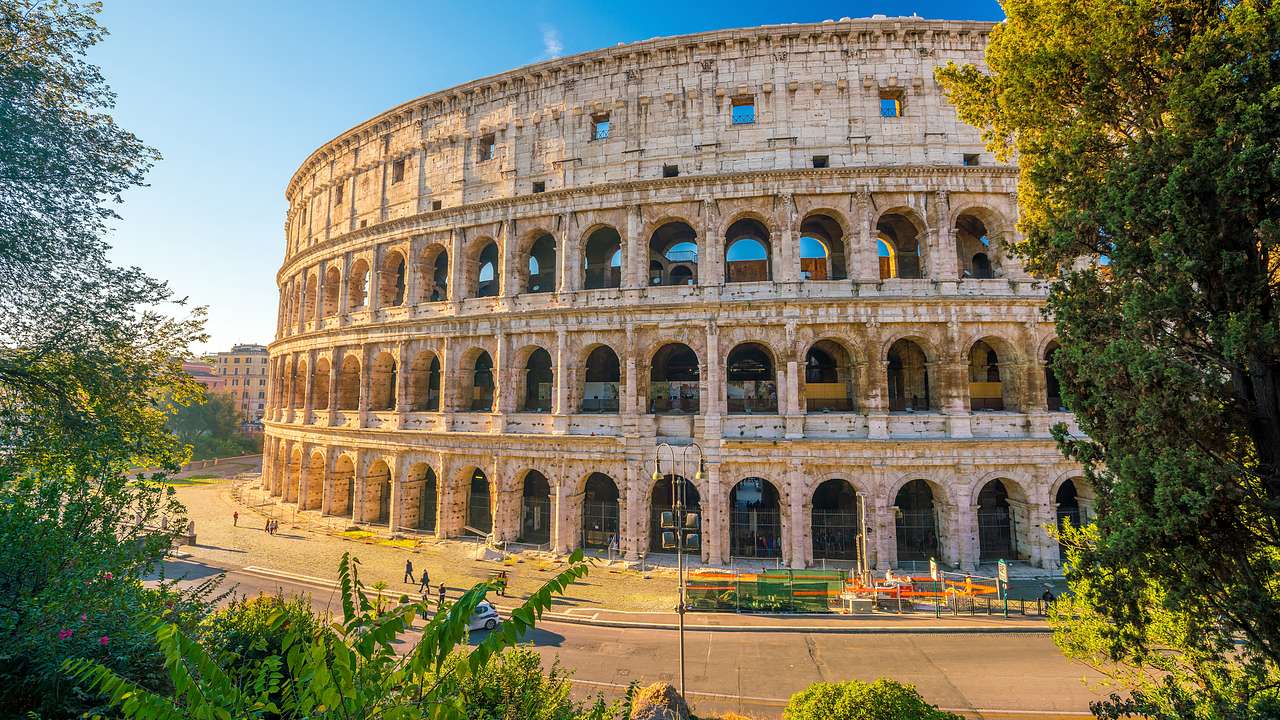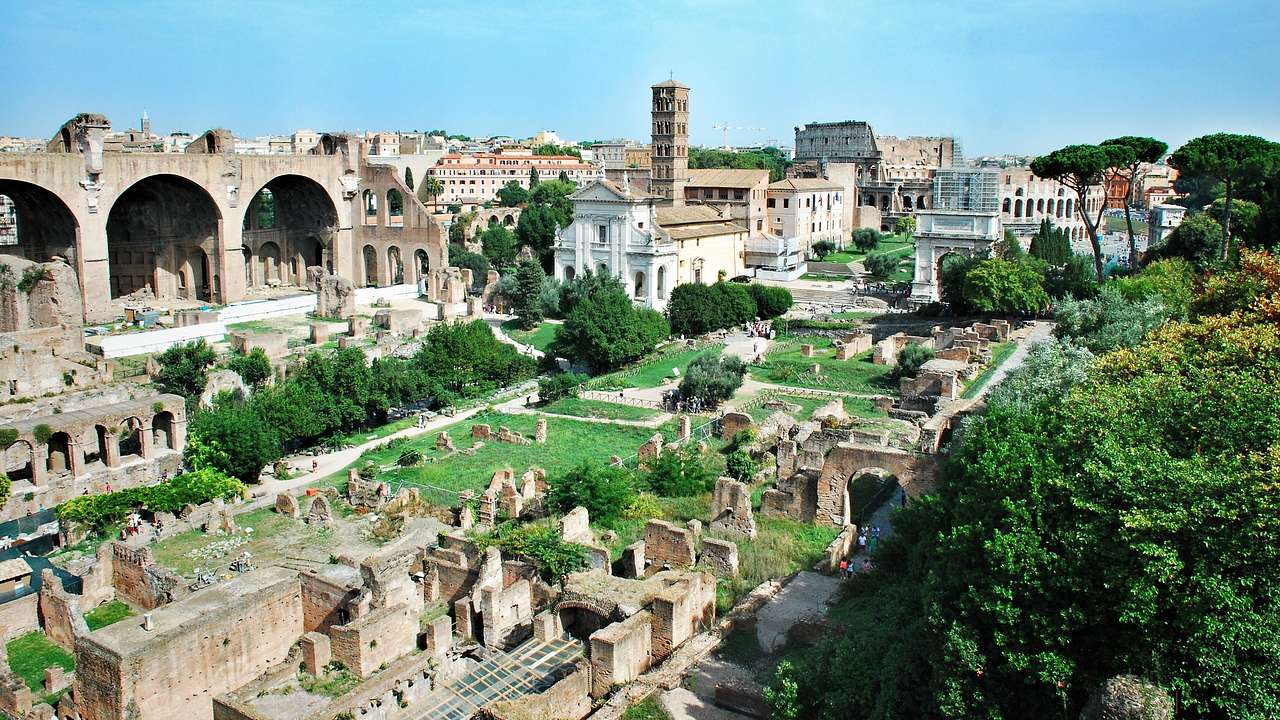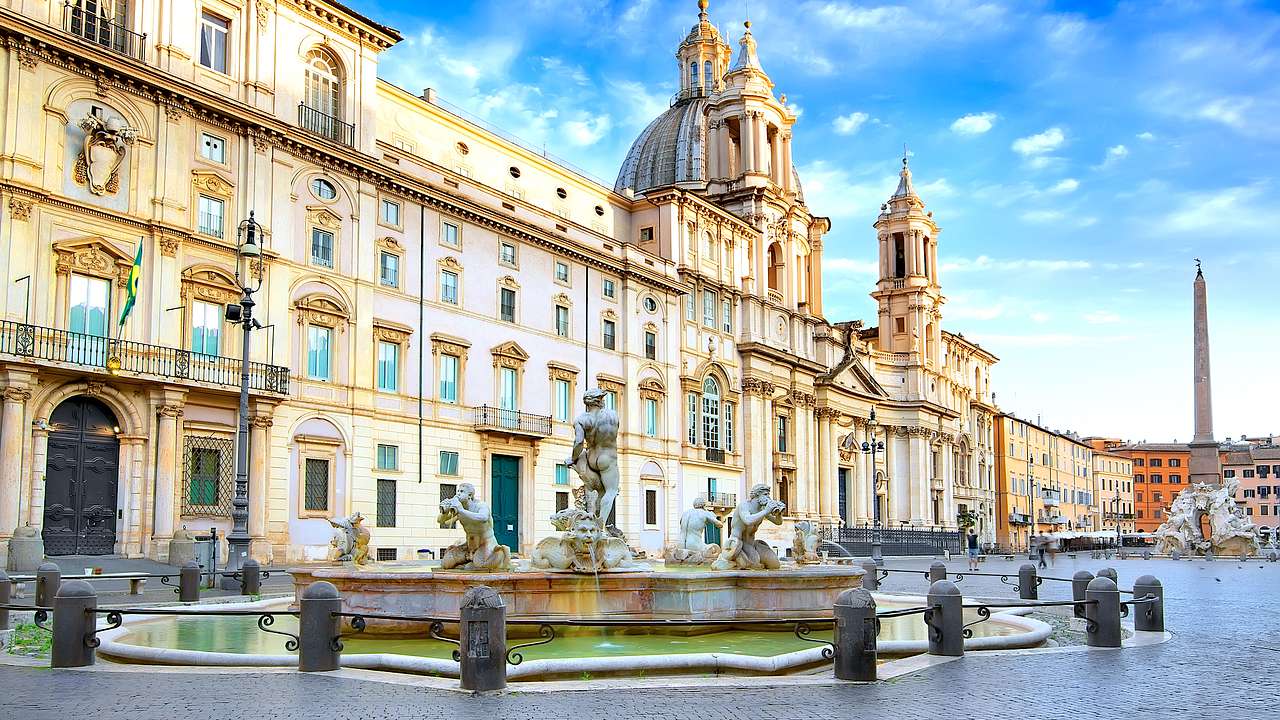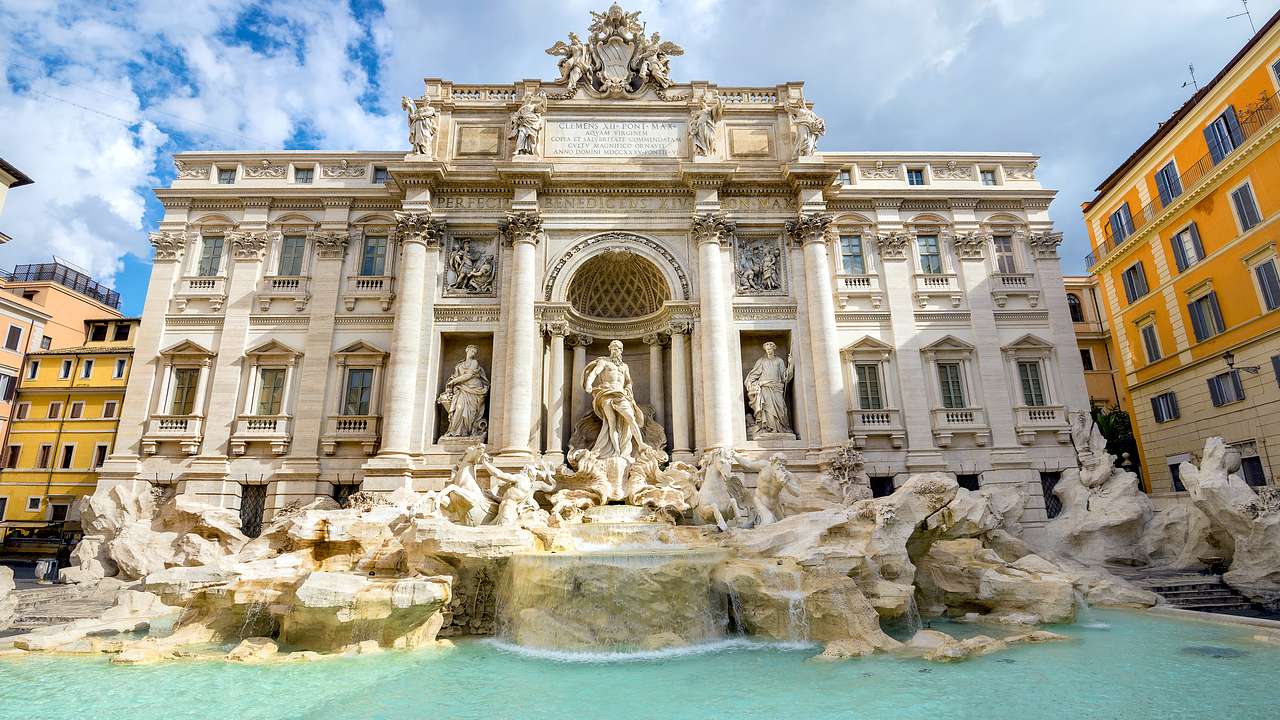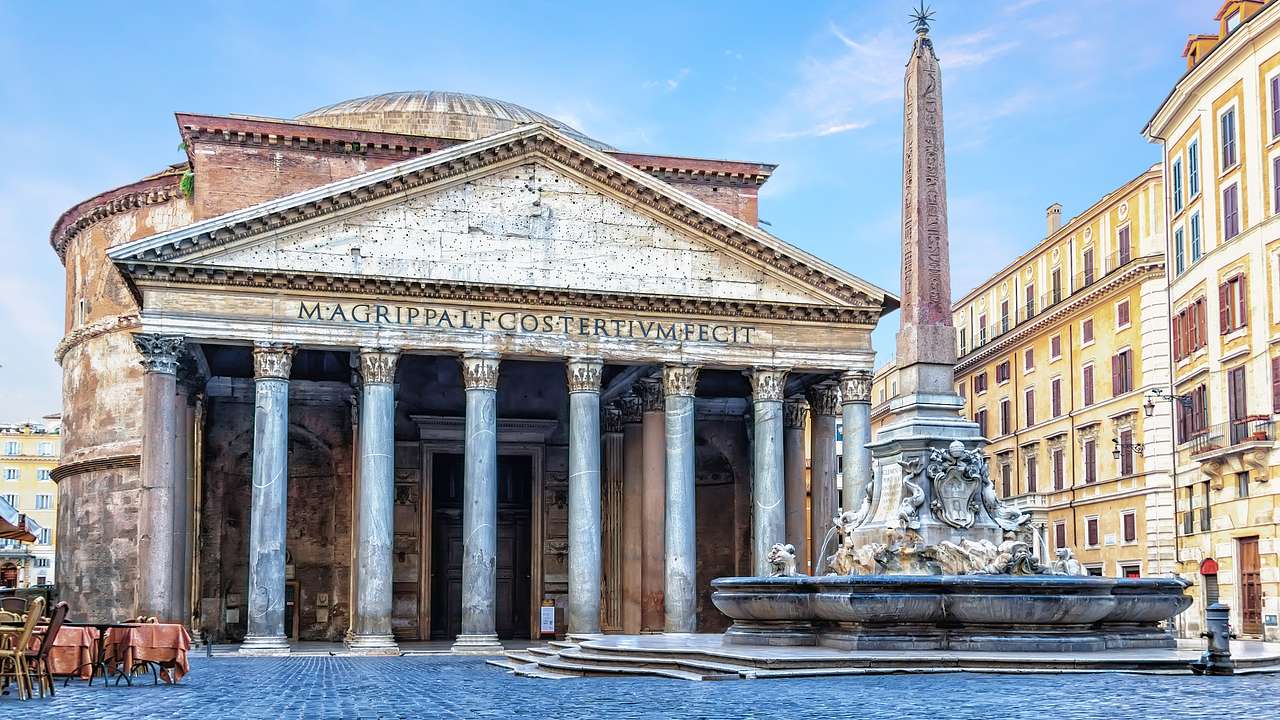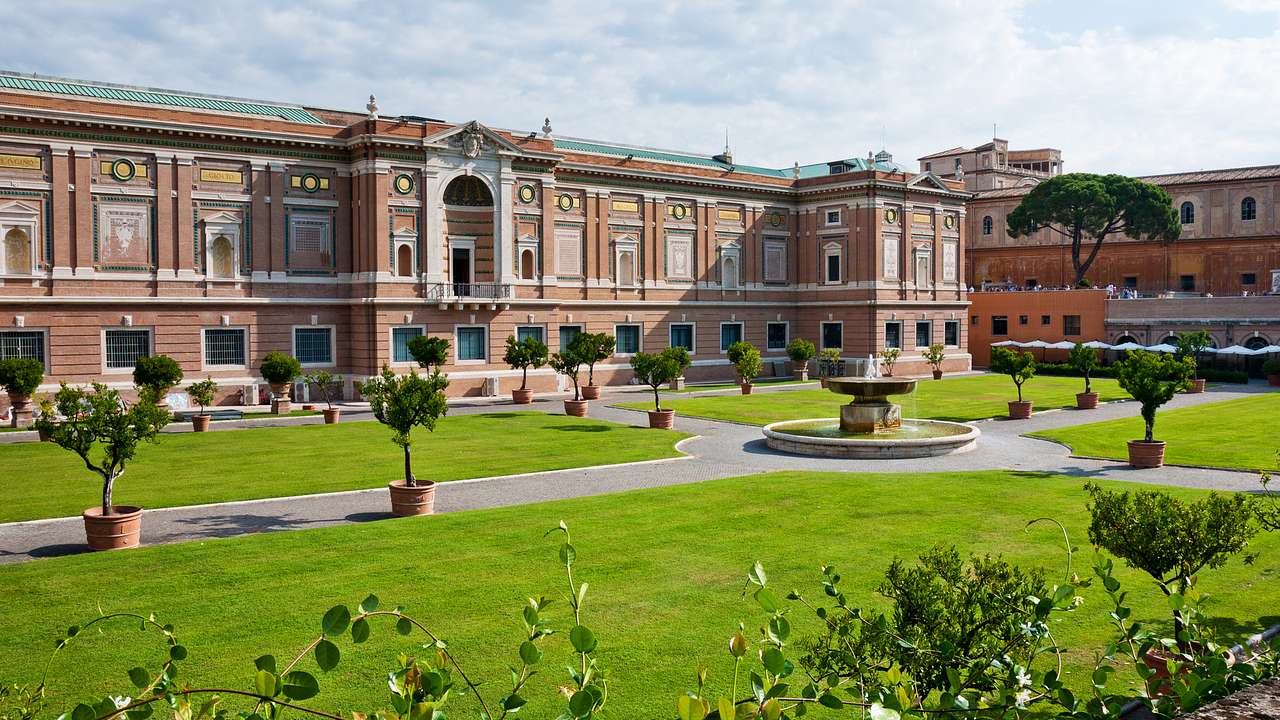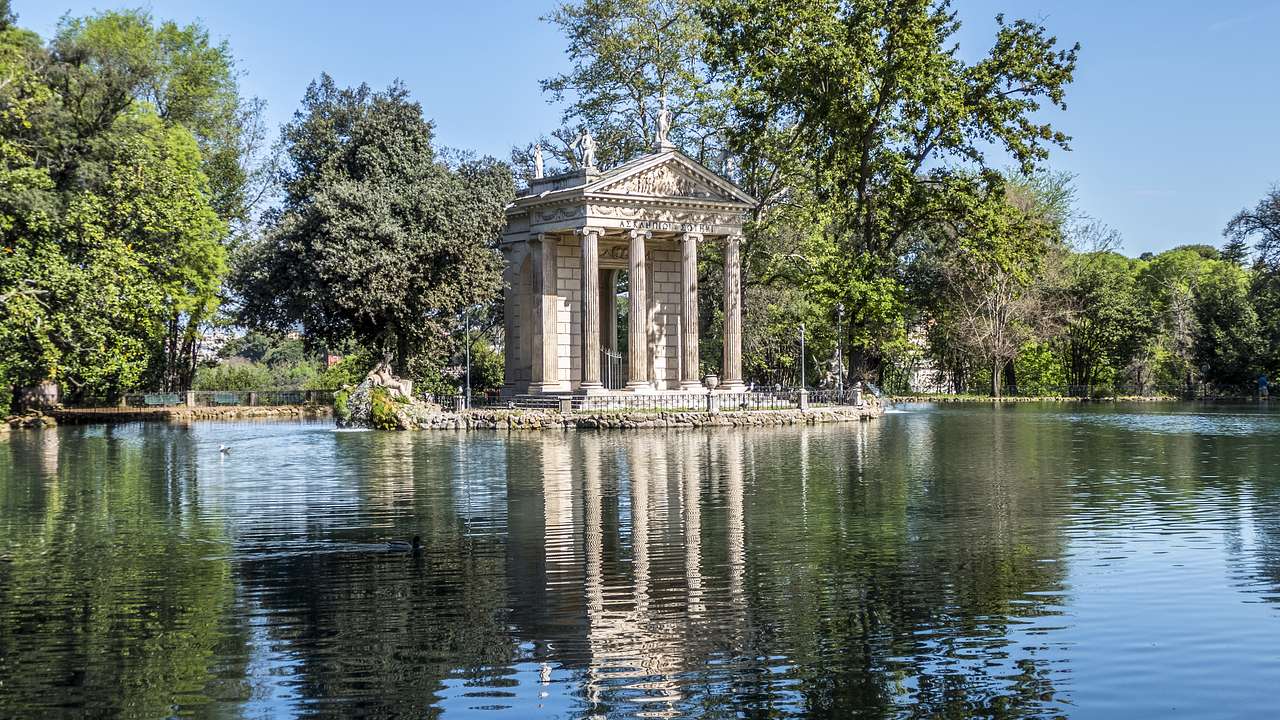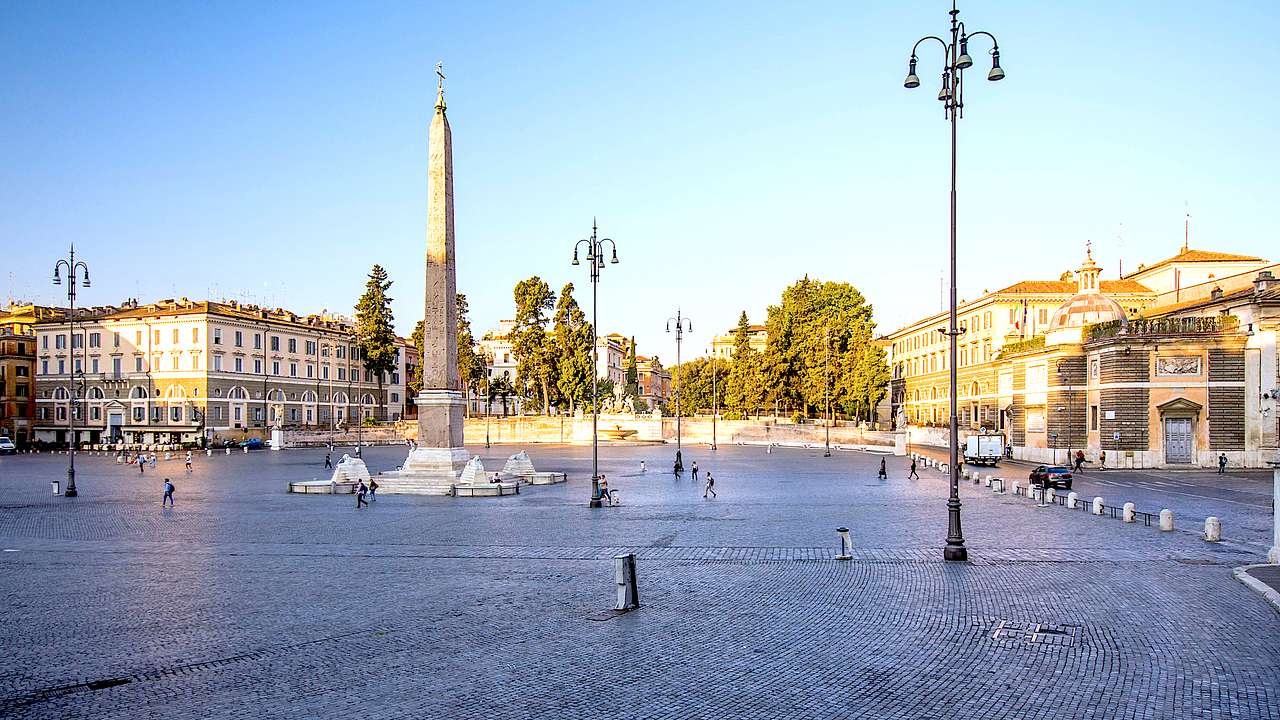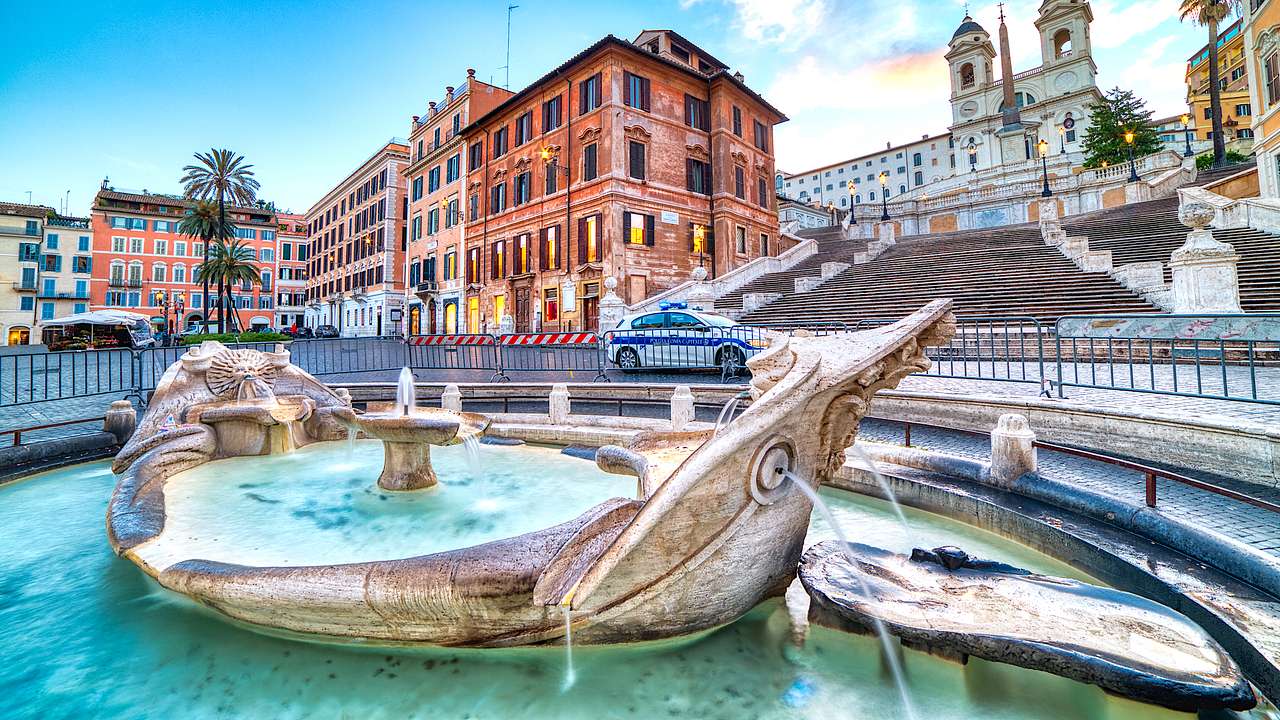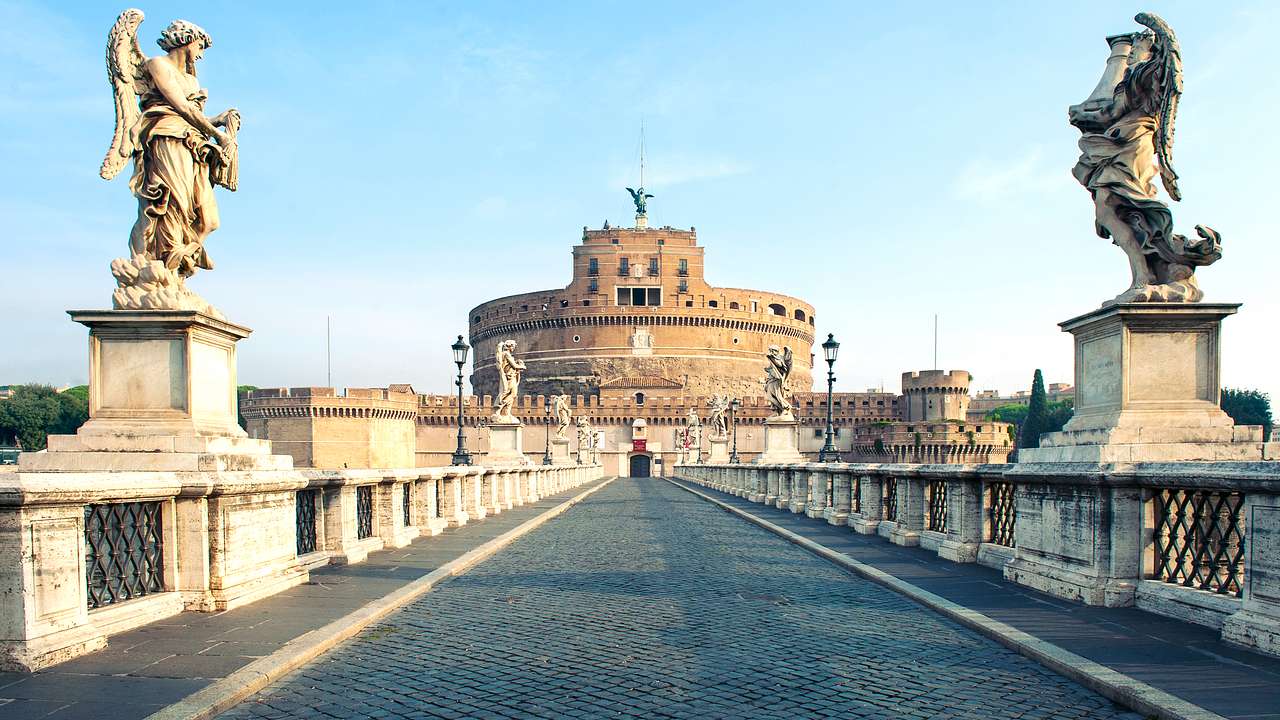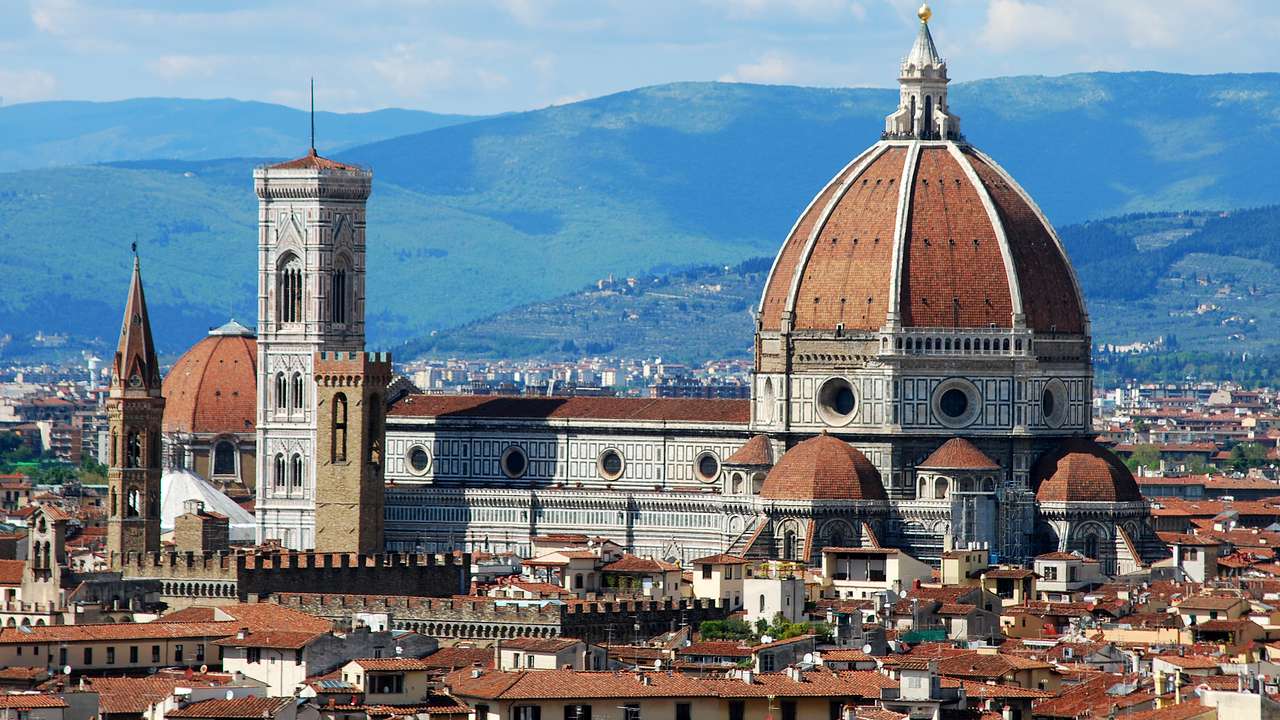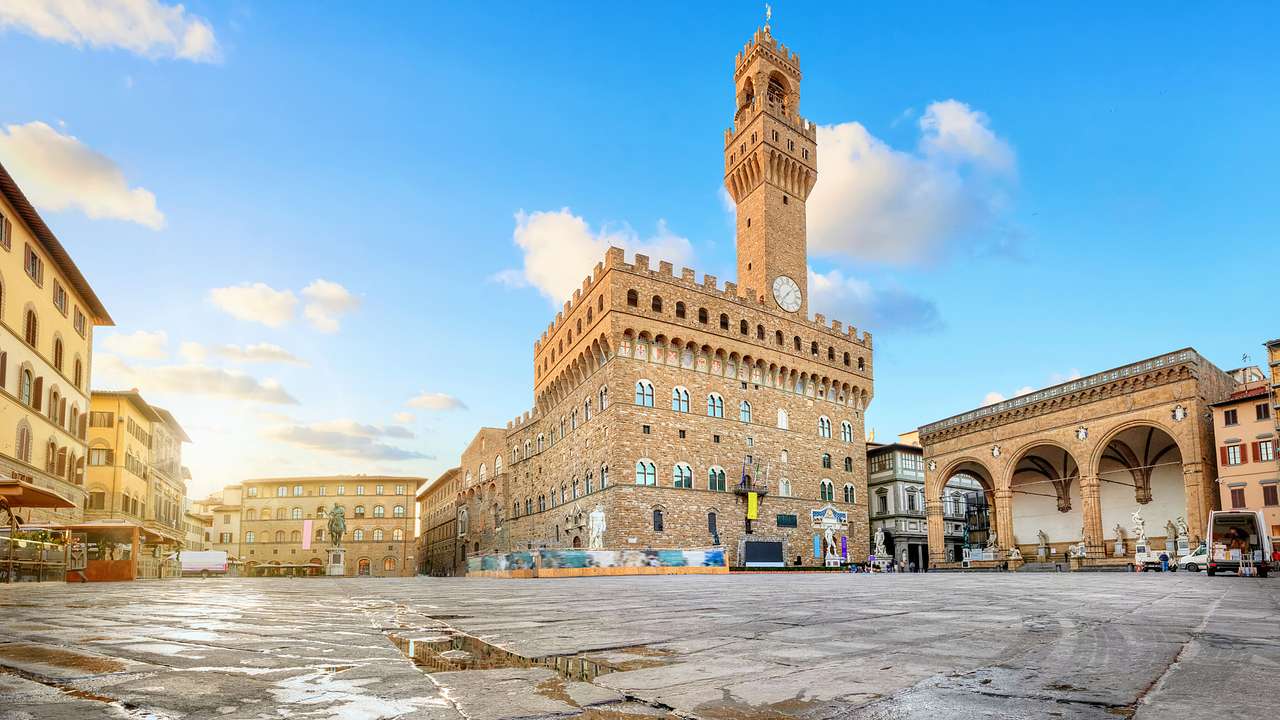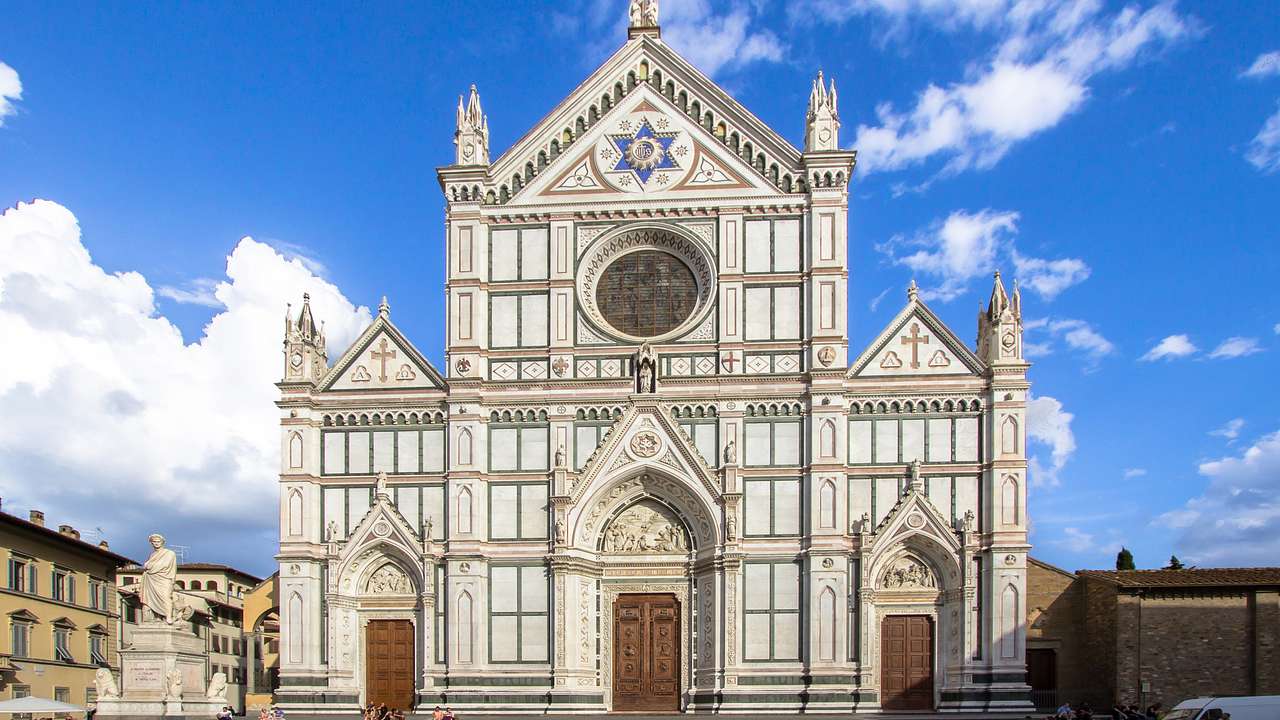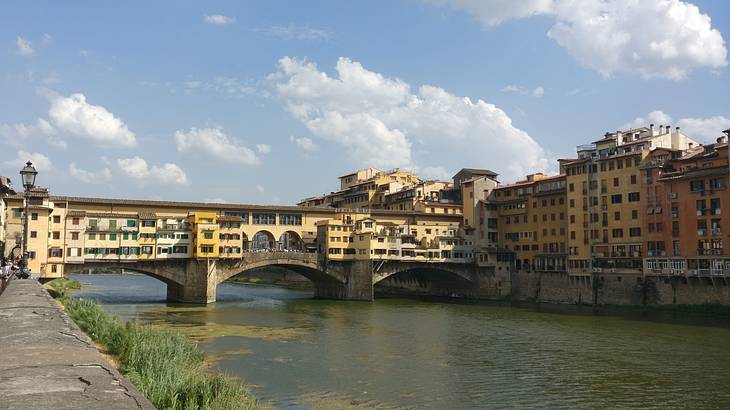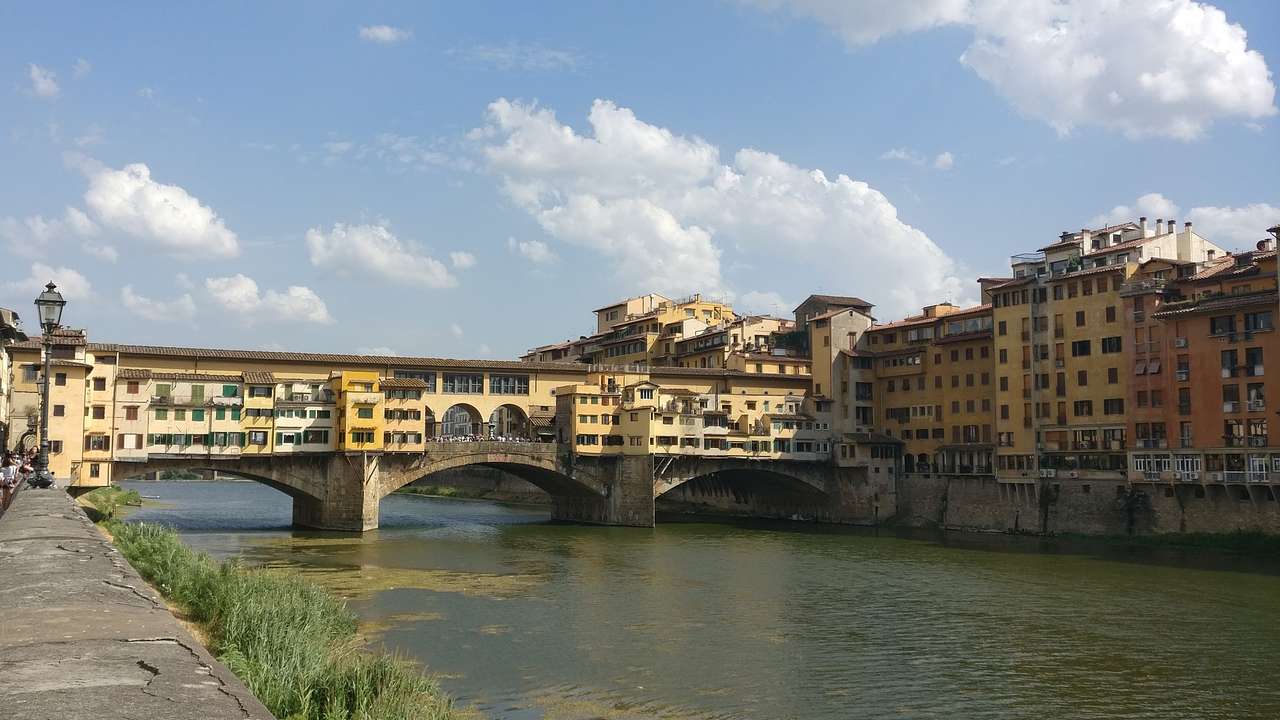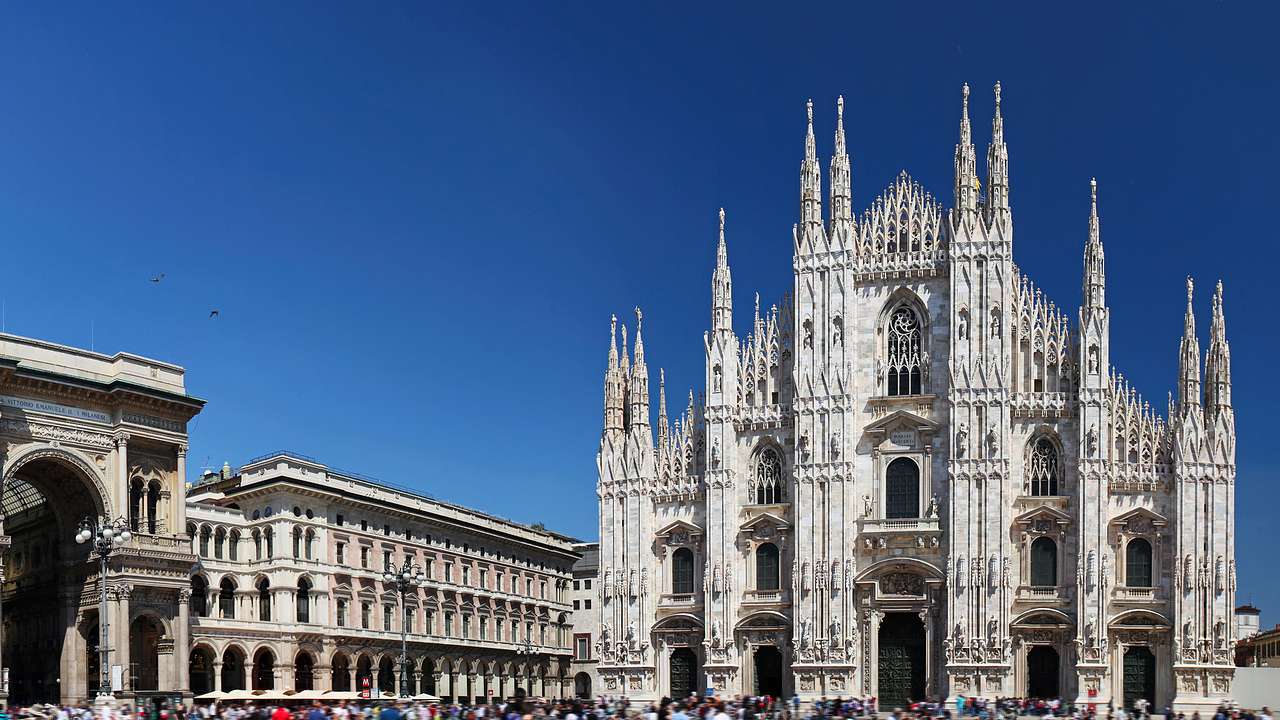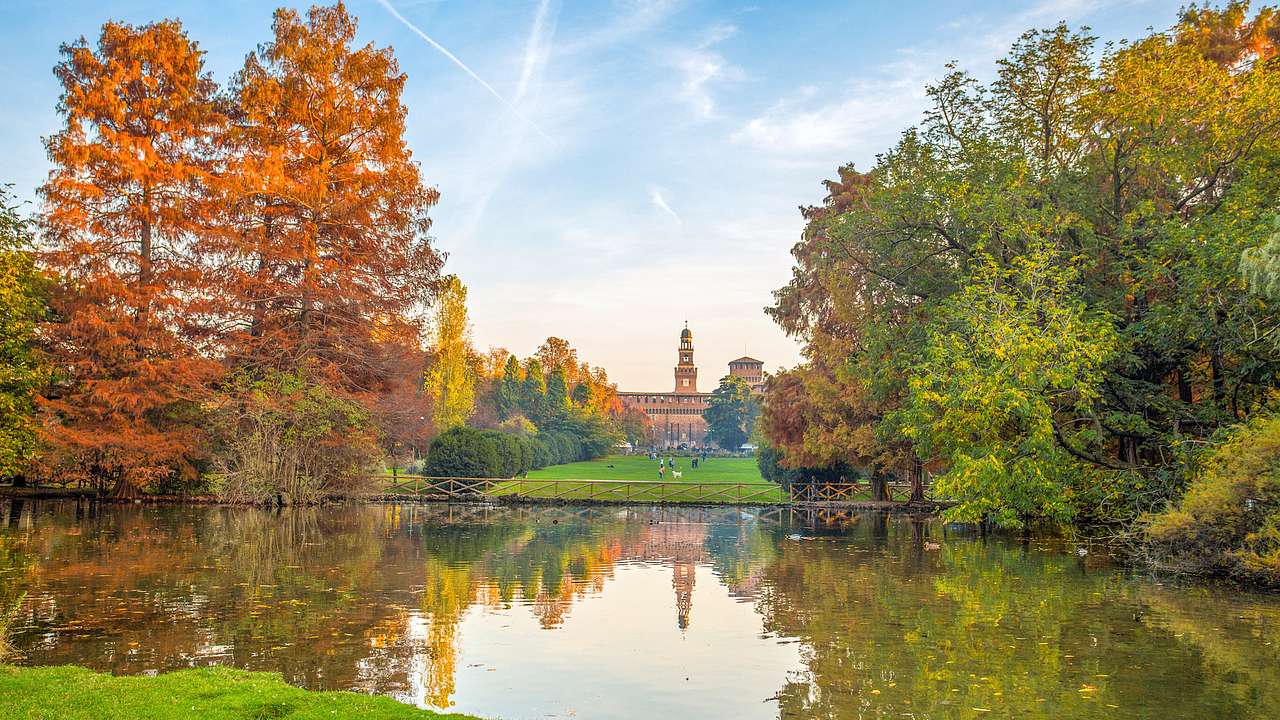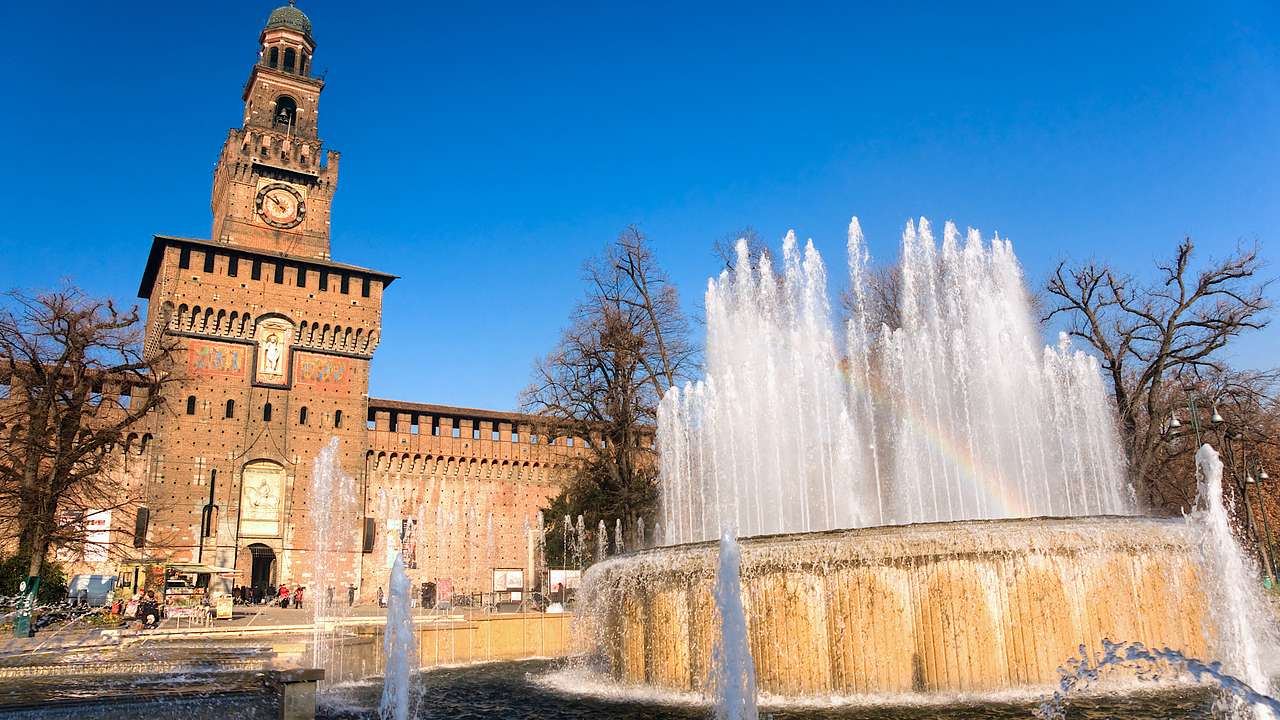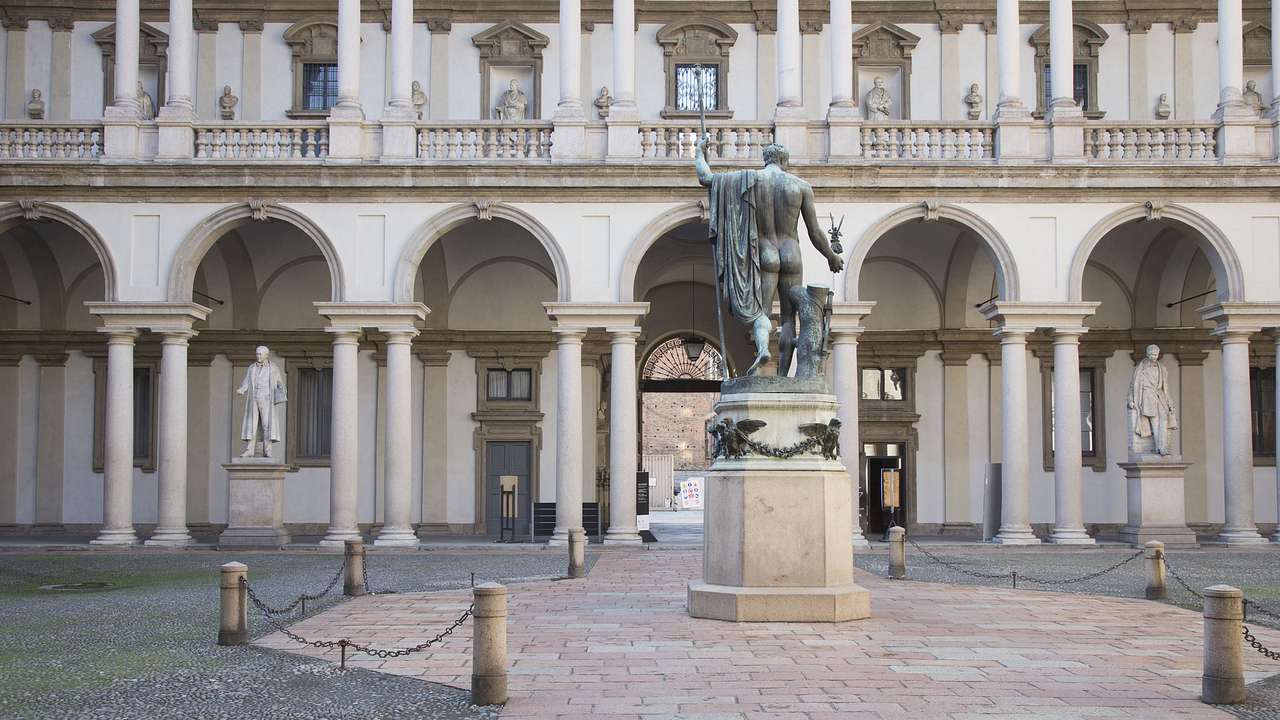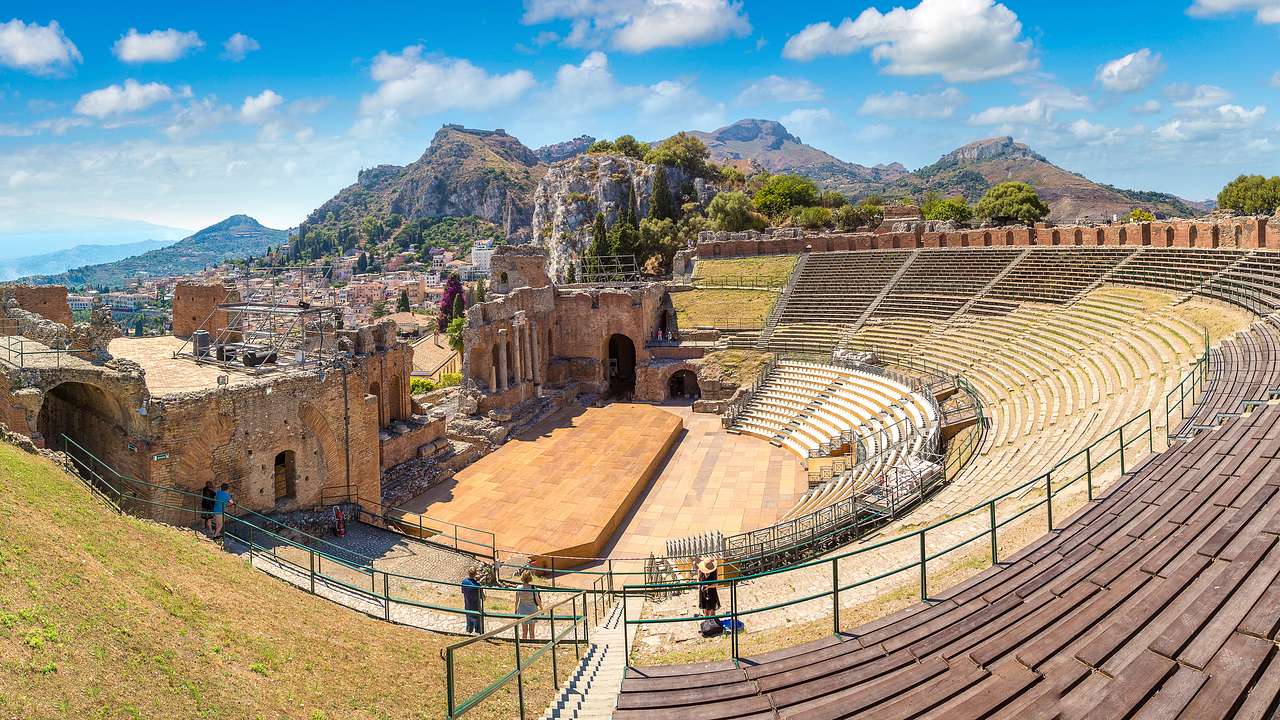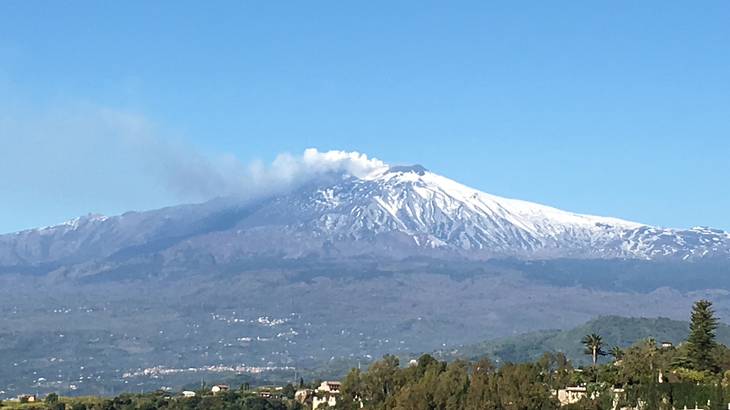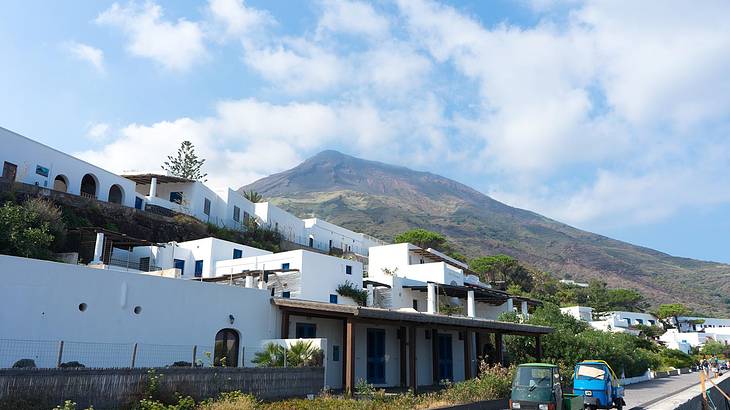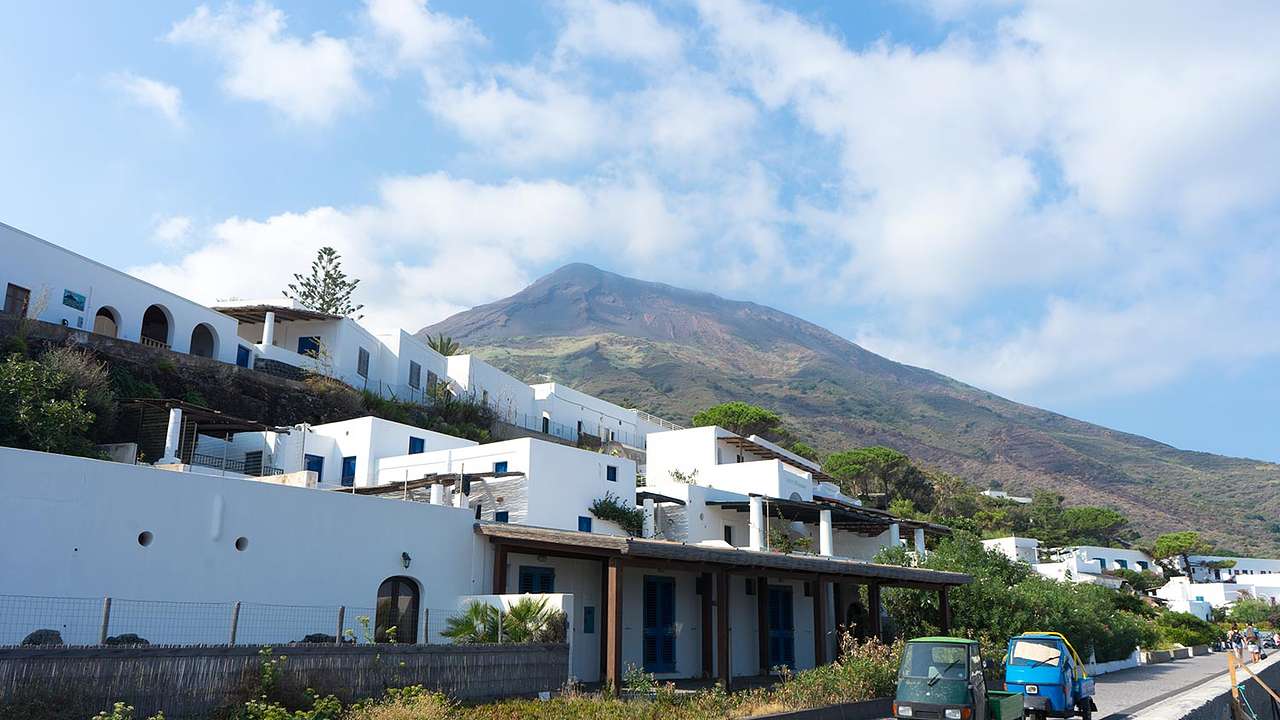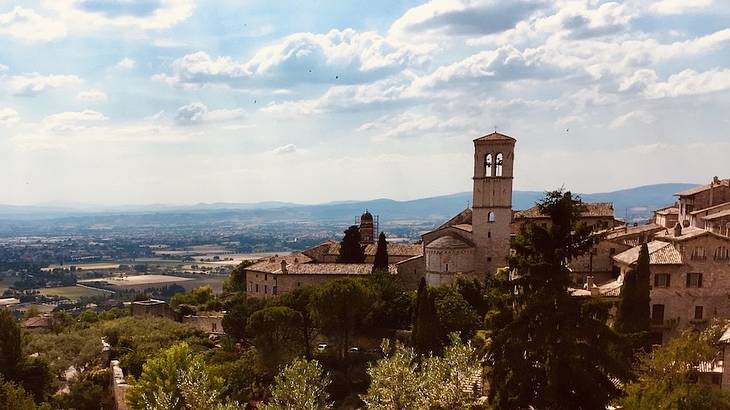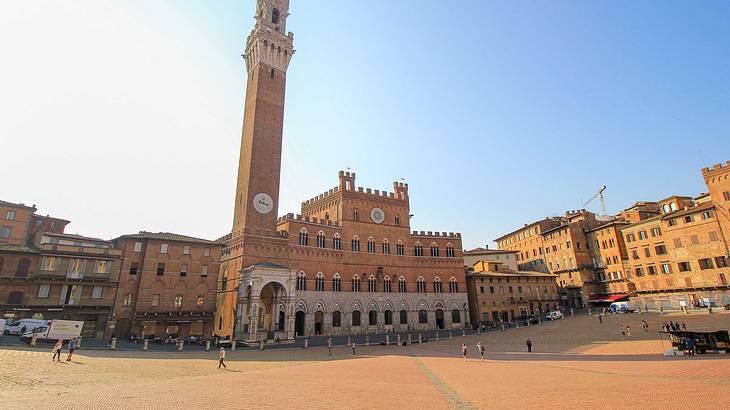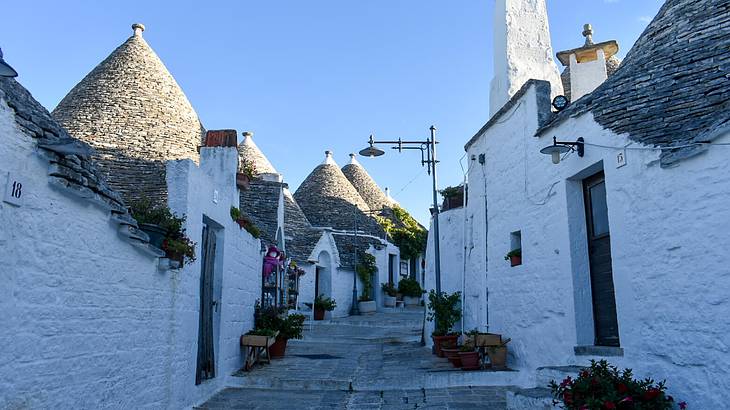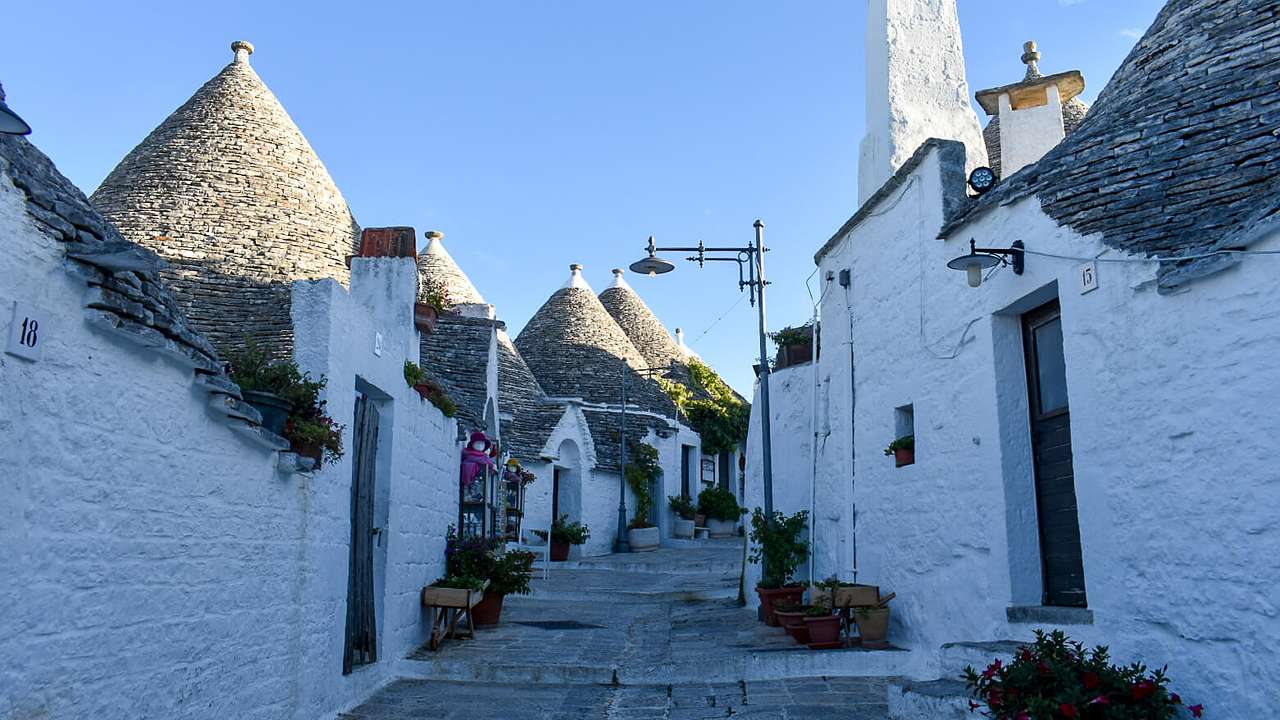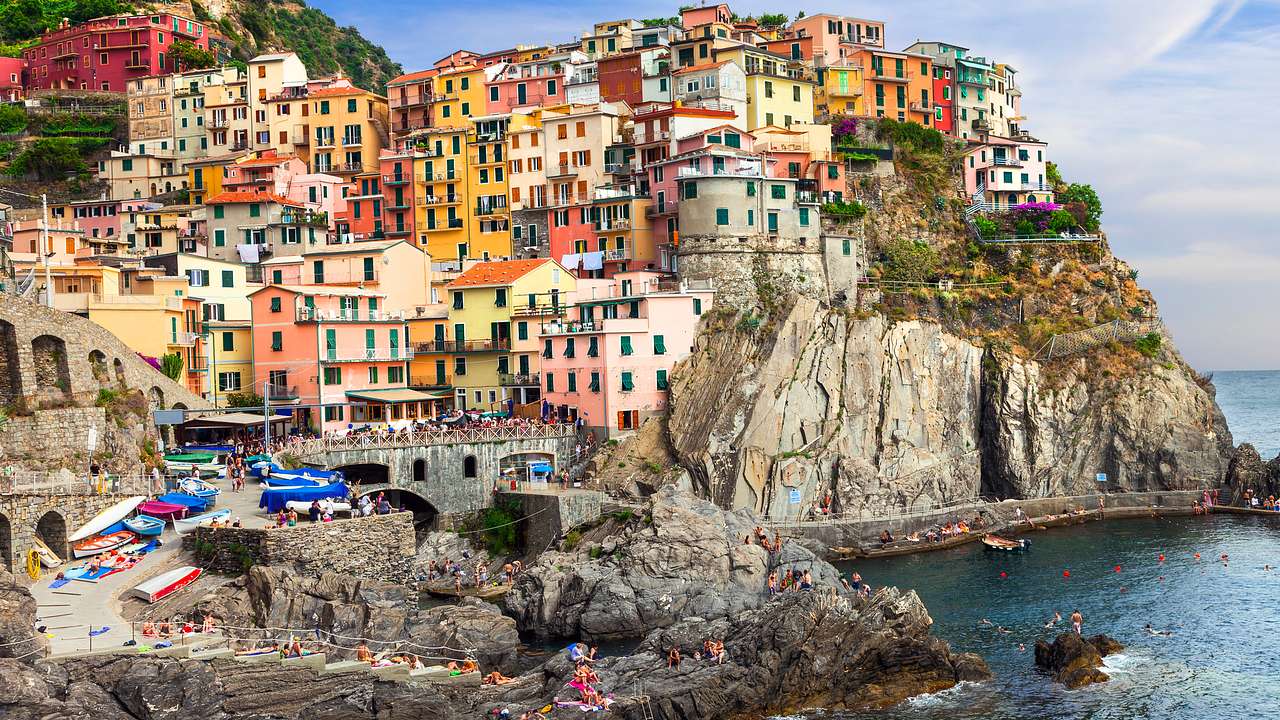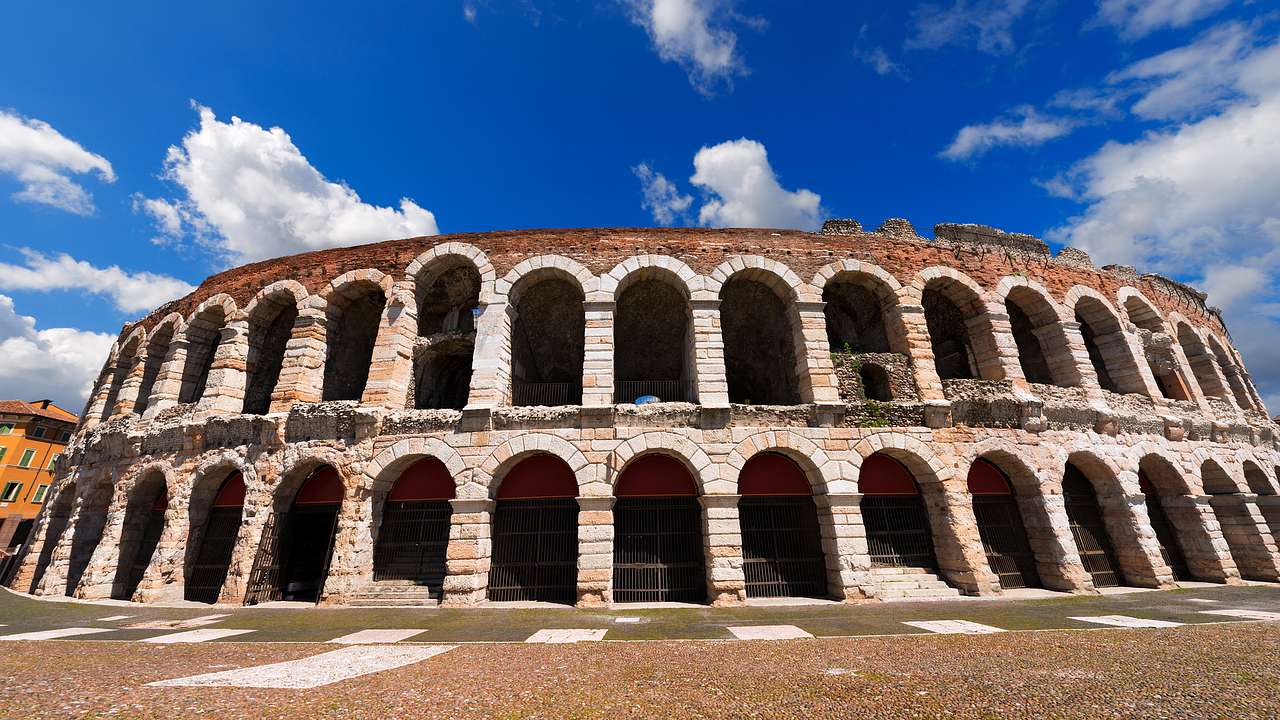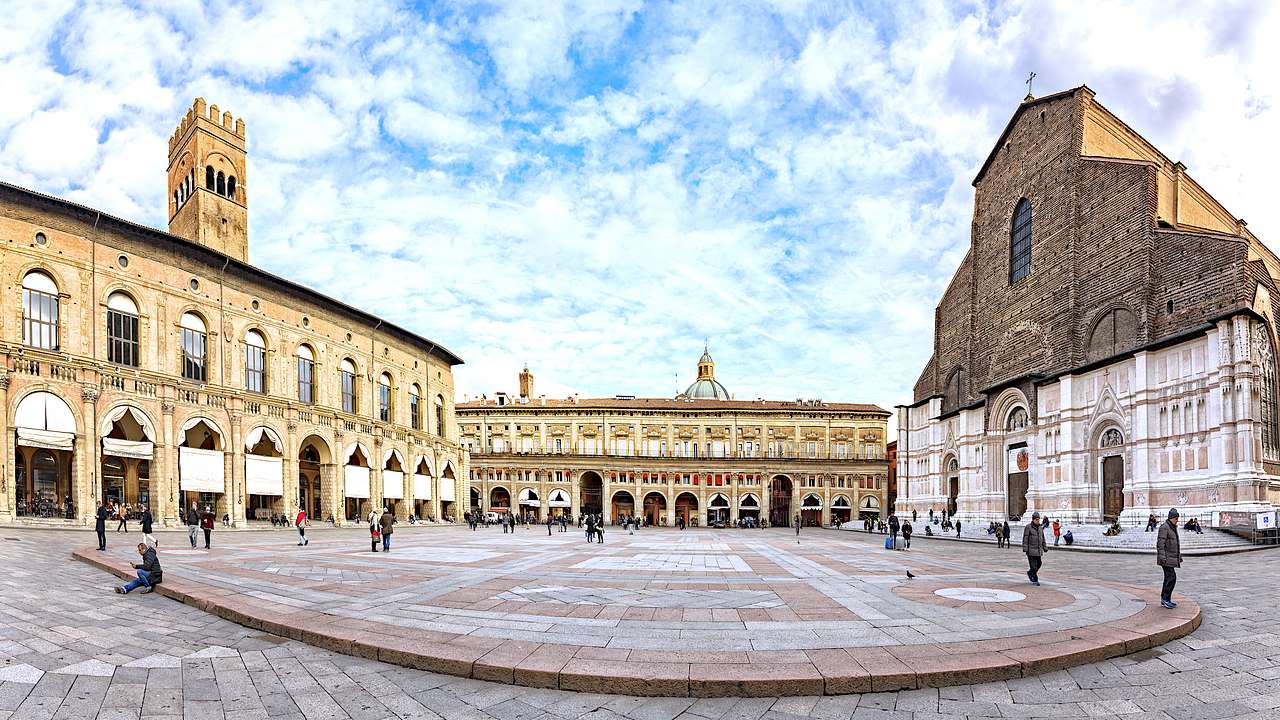38 Famous Landmarks in Italy for Tourists to Visit
Destguides may receive commissions from purchases made through affiliate links in this article.
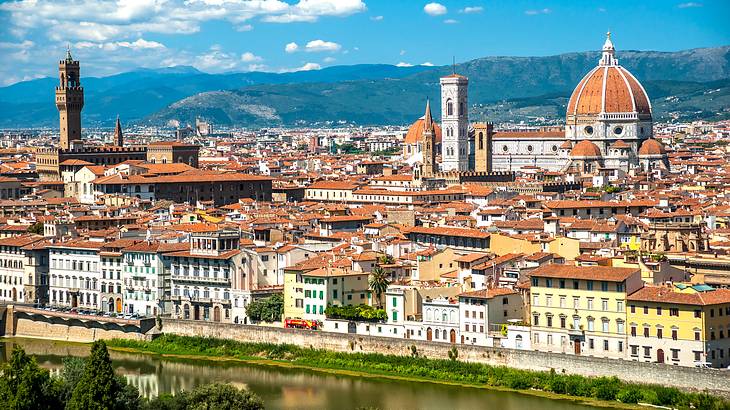
Europe is a continent most people want to travel to when they get a chance to explore the vast selection of European landmarks, attractions, and destinations available. This is mainly because Europe offers various travel experiences, whether you are visiting for a shorter or longer period of time.
Italy is one of the most beautiful countries you can visit in Europe and the world, providing you with memories to last a lifetime. There are many iconic landmarks in Italy that first-time tourists to the country can see. Several of Italy's cities and regions are also top tourist destinations, including well-known locations like Venice, Florence, and Milan.
Less-visited destinations in Italy include Turin and Montefiascone, and one of the best ways to explore this area is by road-tripping through Southern Tuscany. A few areas, like Rome and Sicily, are some of the warmest places to head to for some winter sun in Europe as well.
If this is your first time visiting Italy, planning your Italy trip can be overwhelming as it really does have an endless list of places to visit. This article is a guide, listing some of the most famous Italian landmarks that visitors should consider adding to their Italian bucket list! Some tips from travel bloggers have also been included below.
Planning a last-minute trip to Italy?
When visiting Italy, book your entrance tickets and tours before you go. See the short list of top suggestions below.
☂️ Top tours and experiences in Italy
- Vatican - Museums & Sistine Chapel Entrance Ticket (likely to sell out)
- Skip the Line - Colosseum, Roman Forum & Palatine Hill Guided Tour (likely to sell out)
- Milan - Cathedral & Rooftop Ticket (likely to sell out)
- Vatican Museums, Sistine Chapel & st Peter's Basilica Guided Tour (very popular)
- Tuscany Day Trip From Florence - Siena, San Gimignano, Pisa & Lunch at a Winery (very popular)
38 Famous Landmarks of Italy
- Colosseum, Rome
- Roman Forum, Rome
- Piazza Navona, Rome
- Trevi Fountain, Rome
- The Pantheon, Rome
- St. Peter's Basilica, Rome
- Vatican Museums, Rome
- Sistine Chapel, Rome
- Villa Borghese, Rome
- Piazza del Popolo, Rome
- Piazza di Spagna, Rome
- Castel Sant'Angelo, Rome
- Capitoline Museums, Rome
- Basilica di San Giovanni in Laterano, Rome
- Uffizi Gallery, Florence
- Cathedral of Santa Maria del Fiore, Florence
- Piazza della Signoria, Florence
- Basilica of Santa Croce, Florence
- Bargello National Museum, Florence
- Basilica of Santa Maria Novella, Florence
- Ponte Vecchio, Florence
- Accademia Gallery, Florence
- Duomo di Milano, Milan
- Sempione Park, Milan
- Sforzesco Castle, Milan
- Pinacoteca di Brera, Milan
- Teatro Antico di Taormina, Sicily
- Mount Etna, Sicily
- Stromboli, Aeolian Islands
- Basilica of St. Francis of Assisi, Assisi
- Piazza del Campo, Siena
- Alberobello, Puglia
- Pompeii, Pompei
- Leaning Tower of Pisa, Pisa
- Cinque Terre, Liguria
- Verona Arena, Verona
- Piazza Maggiore, Bologna
- Saint Mark's Basilica, Venice
Italy Landmarks Video
Check out our highlights video of Italy landmarks.
Italy Landmarks Map
A map of Italy landmarks. Use the map to explore all of the points of interest.
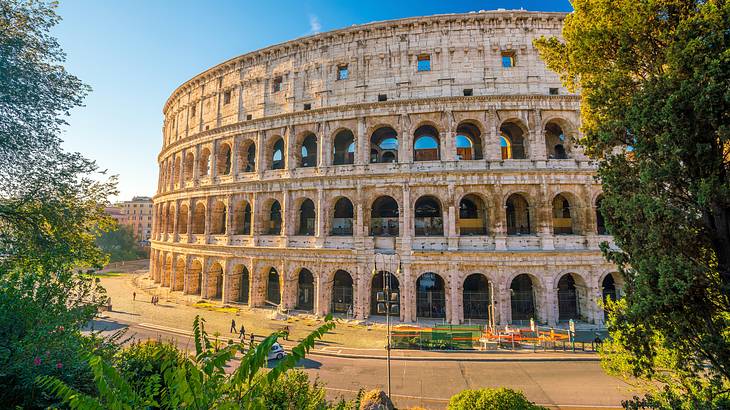
Colosseum, Rome
Visiting Rome for a few days, the capital city of Italy, without seeing the Colosseum would be like visiting Naples and not having a Pizza Margherita.. you just don't do it.
The Colosseum is regarded as a main symbol of the city and is one of the most-visited and famous historical landmarks in Italy. Emperor Vespasian commissioned the Colosseum in 72 AD; however, his son Titus completed it in 80 AD.
Even though the landmark has been continuously used for over 1900 years, the structure is still well preserved. It was added to UNESCO's list of World Heritage Sites in 1980.
Some of the features you must see when you visit this historic site include The Arch of Constantine, The Hypogeum, and The Bronze Cross. Visiting the Colosseum gives you an idea of how life was during the Roman Empire.
Booking a tour in advance that includes skip-the-line privileges and access to the top and bottom floor is recommended (see the Rome itinerary linked above for more information).
☂️ Join a tour to see the Colosseum
- Skip the Line - Colosseum, Roman Forum & Palatine Hill Guided Tour (likely to sell out)
- Expert Guided Tour of Colosseum Underground, Arena & Forum (a top tour)

Roman Forum, Rome
When you think about visiting a popular landmark in Rome, the Colosseum is the first that often comes to mind. The Roman Forum is equally as famous as the Colosseum in Rome, so do not underestimate it!
The Roman Forum is adjacent to Palatine Hill, so you can easily walk from one historical site to another, but they have separate entrances.
If you have watched Roman movies like the Gladiator and Spartacus, you have probably noticed that some of the major scenes are centred around this historic area.
According to history, the rise and fall of the Roman Empire started here. Taking your time walking around the Roman Forum introduces you to how the Roman Empire was founded.
Insider tip: The Roman Forum, Palatine Hill and the Colosseum are all located in the same archaeological park. So set aside about half a day or a full day to explore all three attractions properly.
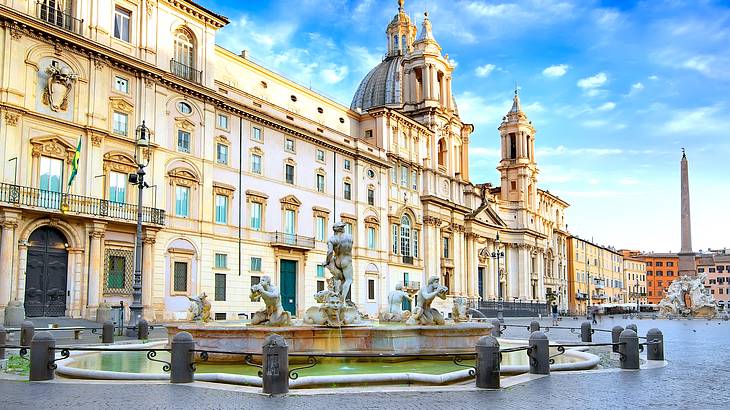
Piazza Navona, Rome
Piazza Navona, translated into English as Navona Square, was initially built as a sporting stadium by Emperor Domitian in 86 BC. The once-popular sporting stadium was later converted into what you see today, a public square, but maintaining its oval shape.
The Square is one of the liveliest places you can be in Rome and is a must for your one day in Rome itinerary. It is filled with many incredible attractions, like a beautiful church, Bernini sculptures, a cast of street artists, and elaborate fountains.
You can locate the Sant'Agnese in Agone Church west of the public square. It was commissioned by Pope Innocent X and designed by Francesco Borromini.
Even though you don't need to visit the church, its location (which is adjacent to the Square) allows you to admire the church's beauty while resting in Piazza Navona.
Insider tip - visit the Square earlier in the morning to avoid the crowds later in the day.
☂️ Visit Piazza Navona with an experience
- Rome in a Day Small Group Tour With Vatican & Colosseum (high demand)
- Rome by Golf Cart Private Tour (well-attended)

Trevi Fountain, Rome
Another major landmark in Italy for you to check out when you travel to Rome is the Trevi Fountain. The Baroque-style water fountain is one of the largest fountains you can find in Rome.
The mix of gushing water with the carved stone always attracts millions of visitors annually, making it one of the most famous buildings in Italy. It serves as a representation of the Eternal City which deals with art, romance, history, beauty and mythology.
Since the Trevi Fountain is one of the most popular spots in Rome, you can visit early in the morning or later in the evening if you dislike being in a crowd. The locals believe that throwing a coin into the fountain assures your return to the Eternal City.
Throwing a second coin in guarantees that you will find love, and a third coin promises marriage. You can try this if you are still looking for that special someone in your life.
☂️ Visit the Trevi Fountain with an experience
- Golf Cart Driving Tour - Rome City Highlights in 25 hrs (highly rated)
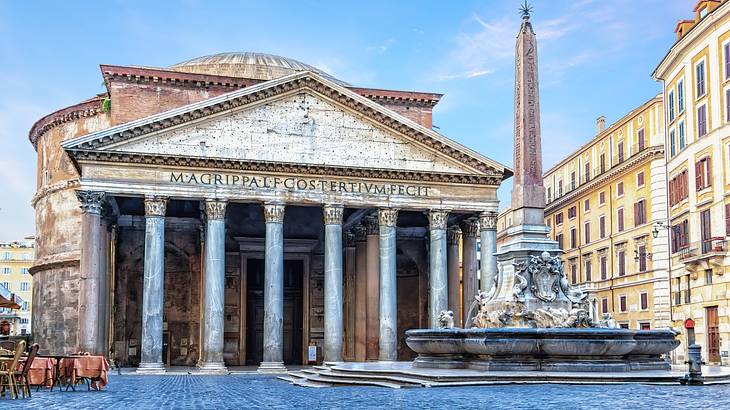
The Pantheon, Rome
As one of the most historical monuments in Italy, the Pantheon is another must-visit monument in Rome. This famous landmark has withstood many challenges ranging from looting, war, and even natural disasters, like earthquakes. It has been standing for over 2,000 years.
The Pantheon was constructed in 27 BC to be used as a temple for the Roman gods. The monument was later rebuilt around 120 AD by Emperor Hadrian after a fire destroyed the original building.
The Pantheon is cherished for its architecture and concept of space. Its design is in the form of a sphere resting in a cylinder. The oculus is the only source of natural light that enters the structure, and it is an opening located at the top of the dome.
Another feature of the landmark is the tombs inserted in the walls, including the tomb of the artist Raphael. You are not allowed to make noise once inside as it is a religious place, but you can take photos to record your experience.
It is highly recommended to come and sit inside the building on a bench to take in the ambience of the space (it is free to enter) while listening to an audio recording about it. Rick Steves' free Pantheon tour recording is an excellent place to begin.
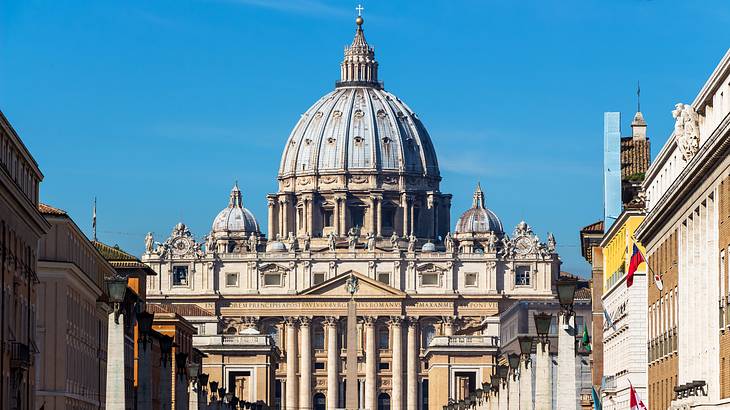
St. Peter's Basilica, Rome
St. Peter's Basilica, presumably built over the tomb of St. Peter, the first pope in Catholic history, is considered to be one of the largest and holiest Catholic institutions in the world.
Construction of the renaissance church began in 1506 and was completed in 1626, with an exterior area of 21,095 square metres. The interior space is about 15,160 square metres and can accommodate up to 20,000 people.
One interesting fact about the Basilica is that it is not thought to be a cathedral, with the reason being that there is no bishop presiding over it.
When you enter the Basilica, you will be blown away by the number of detailed pieces of art you will find in it. Talented artists like Michelangelo and Gian Lorenzo Bernini designed these pieces.
Another impressive part of the Basilica is the Dome, which has served as an inspiration for many cathedrals around the world, like St. Paul's Cathedral in London. Climbing to the top of the Dome gives you a fantastic view of St. Peter's Square and Rome. Make sure to come early in the morning to avoid the crowds.
☂️ Visit St Peters Basilica on a tour
- Early Morning Vatican - Small Group Tour Max Six People or Private (frequently sold out)
- Vatican Museums, Sistine Chapel & st Peter's Basilica Guided Tour (widely sought after)
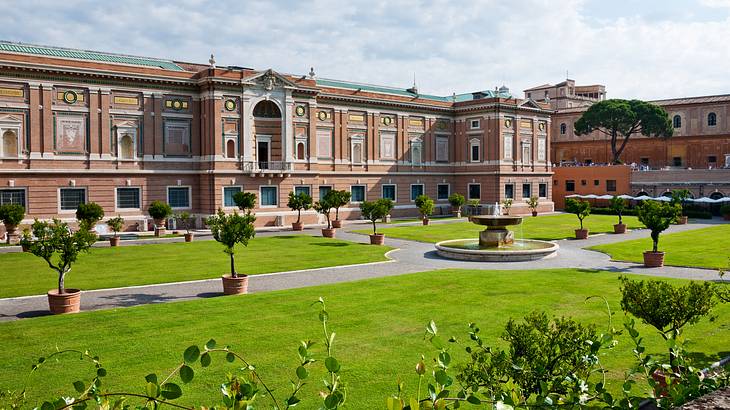
Vatican Museums, Rome
Vatican City is one of the most popular places in Italy and the world at large. This is because it is the headquarters of the Roman Catholic Church and the home of the Pope.
There are several reasons why you should consider visiting the Vatican City once you land in Italy, and the Vatican Museums is one of them. The Vatican Museums is one of the most beautiful and important sites in Rome. It contains the world's largest private art collection.
Aside from the artworks, there are many other attractions for you to see here. Some of these attractions include The Spiral Staircase, The Sistine Chapel, Pinecone Courtyard, and more.
Visiting the Museums and St. Peter's Basilica in one day is recommended because both have a lot of ground to cover and are conveniently located close to each other.
Sistine Chapel, Rome
The Sistine Chapel found in the Vatican Museums is one of the main attractions of the Vatican City. The Chapel was constructed between 1473 and 1481 by the architect Giovanni of Dolci under the mandate of Pope Sixtus IV.
The Sistine Chapel is usually the last place visitors see when visiting the Vatican Museums, reserving the best experience for last. The Chapel is known for its artwork and being the place where popes are elected.
The walls of the Chapel are covered in frescoes done by many important and famous artists. For example, the entire ceiling of the Sistine Chapel is a masterpiece by Michelangelo.
As mentioned above, make sure to do all three sites in one day (the Chapel and the Vatican Museums and St. Peter's Basilica).
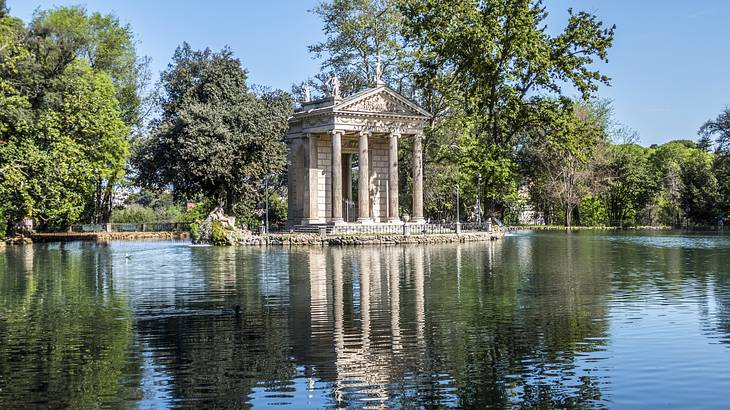
Villa Borghese, Rome
Villa Borghese gardens, popularly known as the green lung of Rome, is a top-rated park in the capital city of Italy. You can locate the park close to the Piazza del Popolo and the Spanish Steps on Pincian Hill.
Villa Borghese was built by the Cardinal Scipione Borghese in 1606, covering a ground area of 80 hectares. His motive for doing this was to convert his former vineyard into an extensive-looking garden.
While he was building the garden, he also commissioned the Villa Borghese Pinciana; a large building that is now a museum within the park.
The Villa Borghese currently houses the Galleria Borghese. You can visit Bioparco di Roma as well, a zoological garden located in the villa that serves as a home for different types of animals.
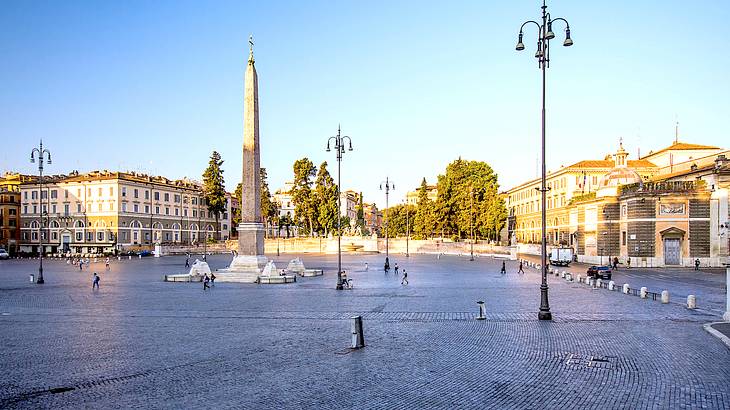
Piazza del Popolo, Rome
Piazza del Popolo, translated into the People's Square in English, can be found near the northern gate of Rome. It was built in 1538 as a way of providing a grand entrance through the north gate of the city, but it has been remodelled several times, with the last remodelling ending in 1823.
When using the northern gate entrance, you might notice the inscription on it which reads, "For a happy and blessed entrance." This message was meant for Queen Christiana when she was travelling to Rome through that gate after converting to Roman Catholicism.
The Square has served as the meeting place for several people over the years. Piazza del Popolo is also popular because it has plenty of attractions for people to see.
One main attraction that draws many visitors to the public square is the Basilica of Santa Maria del Popolo. Other attractions you can visit in the piazza include the Egyptian Obelisk and Santa Maria dei Miracoli, another beautiful church in the square.
☂️ Visit Piazza del Popolo with an experience
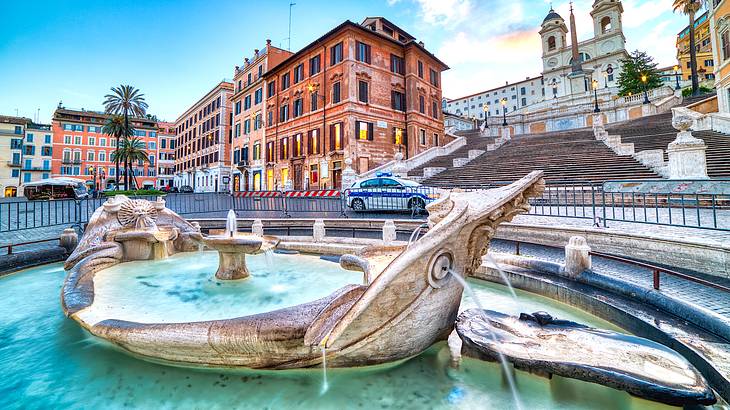
Piazza di Spagna, Rome
Piazza di Spagna, one of the most popular and renowned public squares in Rome, can be located right at the bottom of the Pincio Hill in the city.
The Square is a wonderful representation of Baroque-style architecture and is definitely one of the most-visited landmarks in Rome, Italy.
One main attraction of Piazza di Spagna is the Scalina Spagna, the Spanish Stairs. The staircase was built between 1723 and 1725 by Pope Benedict XIII. It has become an emblem of Rome and a place for many to relax and enjoy the view of Piazza di Spagna.
Another attraction of the square worthy of your time is the Fontana della Barcaccia, the Fountain of the Ugly Boat. As you might have guessed, the fountain is shaped like a boat. You can also check out the stunning Trinità dei Monti church if you have enough time to spare.
☂️ Explore the Piazza di Spagna with a tour

Castel Sant'Angelo, Rome
I will admit that Castel Sant'Angelo is not a tourist attraction that many visitors add to their Rome or Italy itinerary, but this does not mean that it's not worthy of a visit; it means the opposite. This Castle, just like other similar historical monuments in Rome, gives you a taste of Roman history.
Construction of the Castle began in 135, with it being completed in 139 A.D. under Emperor Hadrian. He wanted the Castle to serve as a mausoleum for him and his family.
It is believed the Castle was named after Angel Micheal in 590 when Pope Gregory I dreamt of an incident whereby he saw the angel on top of the Castle ending an epidemic facing the city.
Castel Sant'Angelo is divided into five floors, with Museo Nazionale di Castel Sant'Angelo being one of its top attractions. The Castle, located near St. Peter's Basilica, offers a fantastic view of Rome from its rooftop as well.
☂️ Visit Castel SantAngelo with a tour
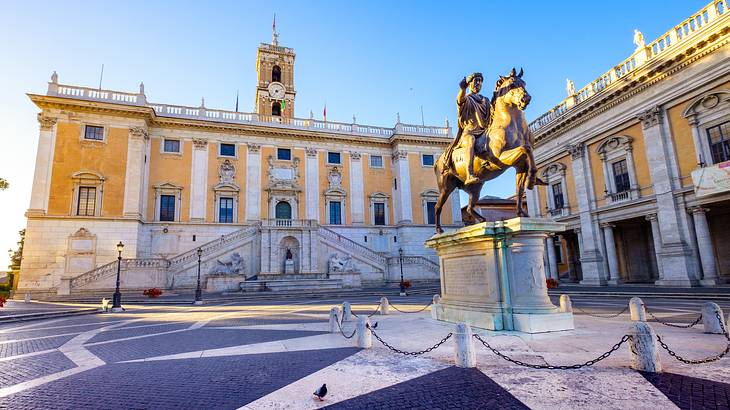
Capitoline Museums, Rome
The Capitoline Museums is another set of historical museums that is easy to find in Rome because of its popularity. It can be located on one of the seven famous hills in Rome, Capitoline Hill, in the Piazza del Campidoglio.
Capitoline Museums is actually two buildings that have been turned into one large museum. Pope Sixtus IV started the historical journey of the museums when he donated an important collection of bronze statues in 1471 to the people of Rome.
The collections gathered in the museums continued to grow until it was declared a public museum in 1734 by Pope Clement XII.
Today, the Capitoline Museums holds an extensive collection of Romanesque paintings and sculptures. The Capitoline Museums is the most important museum for you to visit in Rome after the Vatican Museums.
☂️ Visit the Capitoline Museums on a tour
- Civitavecchia Shore Excursion - Best of Rome Private Tour (frequently earns a five-star rating)
- Percy Jackson Rome - Hunt For Heroes
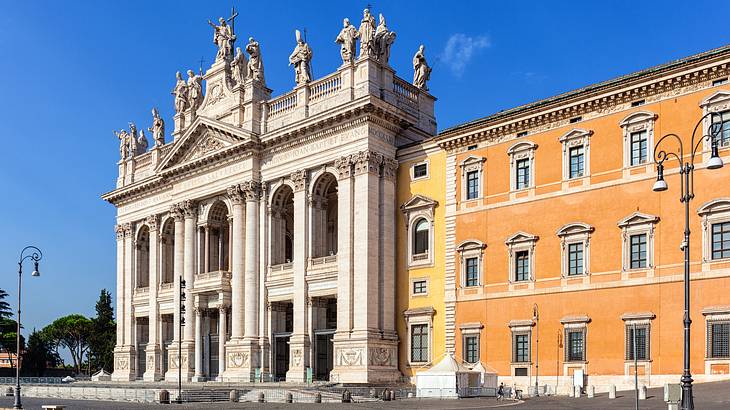
Basilica di San Giovanni in Laterano, Rome
Basilica di San Giovanni in Laterano, or simply the Basilica of St. John Lateran, was built in the fourth century as a way of honouring St. John the Baptist and John the Evangelist.
The Basilica is located in Rome and is one of the most important churches in the city. It is also considered to be the mother church of the Roman Catholic faithful and is the official seat of the Pope.
The interior of the Basilica is a beautiful example of what one can achieve by mixing both baroque and neoclassical architectural styles. It is filled with mosaics, colossal statues and frescoes covering the ceilings to the ground.
You can visit the Scala Santa (The Holy Stairs) as well, relocated from Jerusalem to Rome. It is believed that Jesus Christ stepped on them before his crucifixion.
☂️ Visit the Basilica di San Giovanni in Laterano on a tour
- Rome - Underground Temples & Crucifixion Relics Walking Tour (often fully booked)
- Christian Rome With English Speaking Driver (widely acclaimed)

Uffizi Gallery, Florence
The Uffizi Gallery, located in Florence, is a major landmark in Italy and one of the most-visited museums in the country. Construction of the museum began in 1560 and was completed in 1581.
Millions of visitors travel to Florence just to observe the remarkable works of art it displays from well-known artists. The Uffizi Gallery houses one of the world's most important collection of paintings, as well as a large number of foreign art and sculptures.
The artworks found in the museum are the works of artists like Leonardo da Vinci, Michelangelo, and Botticelli. These works of art were made between 1300 and 1500, serving as a guide to Western art.
The Uffizi Gallery is a must-visit museum if you love all forms of art. I definitely recommend visiting the Uffizi Gallery when you happen to be in Florence next.
☂️ Visit the Uffizi Gallery on a tour

Cathedral of Santa Maria del Fiore, Florence
The Cathedral of Santa Maria del Fiore, also known as the Duomo di Firenze or the Florence Cathedral, is another famous monument located in Florence. It is a symbol of the city, being one of the most-visited tourist attractions in Florence.
The Cathedral is a Renaissance church designed by Arnolfo di Cambio in 1296 and completed by Filippo Brunelleschi. It was built to show how the city was 'progressing'. The Church is 152 metres long and 90 meters wide, making it the third-largest church in Italy.
The artistry represented by the Florence Cathedral is what makes it one of the must-see monuments in Florence. The front of the Church, known as the façade, was completed in the 1800s.
☂️ See the Cathedral of Santa Maria del Fiore on a tour
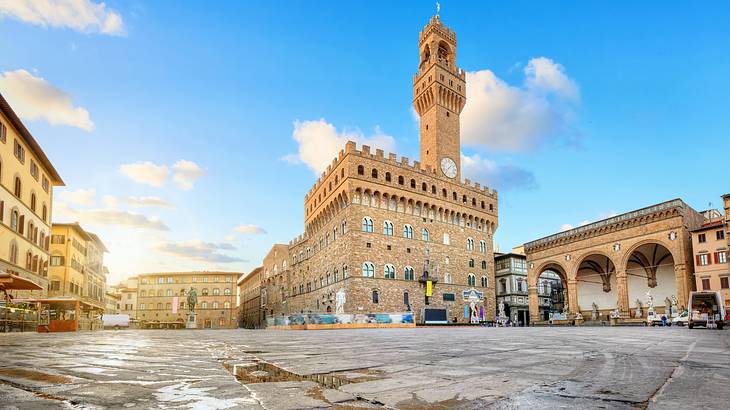
Piazza della Signoria, Florence
Piazza della Signoria, also known as the Old Palace, is a public square known to be the political centre of Florence since the 14th century.
This same public square has been the venue for several public celebrations, an example being the return of the Medici in 1530. Piazza della Signoria has many attractions that draw tourists to it when they are in Florence.
Some of the attractions include the Uffizi Gallery, The Neptune Fountain, and copies of statues designed by Michelangelo and Donatello.
☂️ Visit Piazza della Signoria on a tour
- Skip-the-Line Florence Highlights & David Walking Tour (often fully booked)
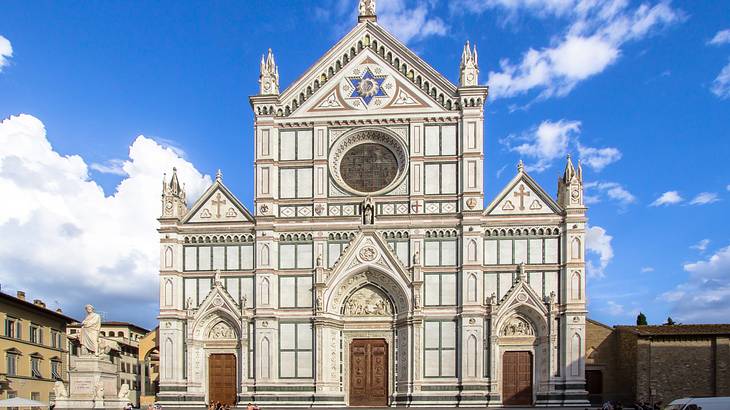
Basilica of Santa Croce, Florence
Having a measurement of 115 metres in length and 38 metres in width, the Basilica of Santa Croce is one of the famous monuments in Florence. It is the largest Franciscan church in the world and the second largest in Florence after the Duomo.
Construction of the Basilica was completed in 1294. It possesses an artistic nature showcasing frescoes by Taddeo Gaddi and Giotto.
The Basilica of Santa Croce in Florence also holds the tombs of well-known people in history, such as Michelangelo, Galileo, and Dante. It draws many visitors annually because of the magnificent art it displays inside as well.
Other attractions of the Basilica include the Pazzi Chapel and a small museum holding artwork that has been collected over the years.
☂️ Visit the Basilica of Santa Croce in Florence with a tour

Bargello National Museum, Florence
Museo Nazionale del Bargello, or the Bargello National Museum, is a museum that is focused on exhibiting medieval and renaissance art.
The museum is famous for displaying some of the best sculptures made by the artist Donatello. It also holds fine art pieces from other renowned artists like Michelangelo and Benvenuto Cellini.
The museum, which opened in 1865, is located in Palazzo del Bargello in Florence. The Bargello National Museum is relatively small when compared to the Uffizi Gallery, but it is still rich in art.
Many visitors prefer to visit the two main rooms containing renaissance art, but the museum has other unique features for you to explore. The main building itself is an art piece that is worth exploring.
Aside from the sculptures which make the museum well-known, it houses a collection of goldwork and enamels that have been gathered from the Middle Ages up to the 16th century.
The Bargello National Museum is the place to be when you want to admire renaissance art or sculptures, and it should be included on your 3 days in Florence itinerary.
☂️ Join a tour to see the Bargello National Museum
- Bargello Museum Tour in Florence (widely acclaimed)
- The Dark Side of Florence - Mysteries & Legends (a hit among most)
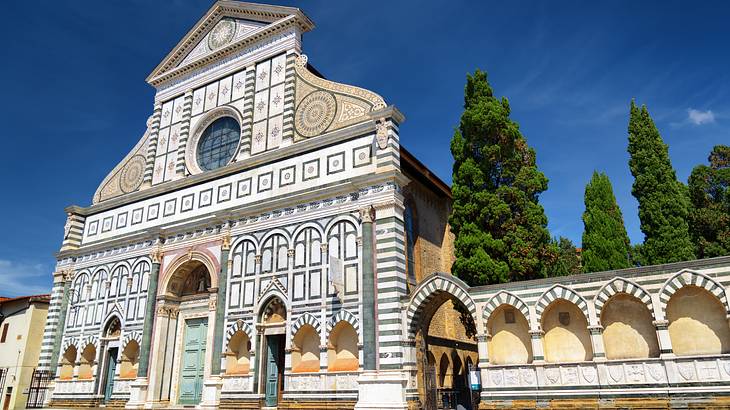
Basilica of Santa Maria Novella, Florence
Basilica of Santa Maria Novella is one of the most important and major churches in Florence, Italy. The white and green façade (front of the church) was built during the 13th and 14th centuries.
The architectural style of the Basilica is a mix of Gothic and Renaissance. Leon Battista Alberti designed the upper section and the main doorway of the Basilica, which was built from 1456 to 1570.
The Basilica's interior certainly proves that it is in the ranks of being one of the most beautiful churches in Florence. Some of the highlights of the Basilica include the carved crucifix by Brunelleschi, Masaccio's Holy Trinity of 1424, and a large painting of the crucifix by Giotto from 1290.
☂️ Experience the Basilica of Santa Maria Novella with a tour
- Florence Golf Cart Tour - Half Day - Guided Tour (highly rated)
- Electric Cart Tour of Florence (popular with most)
Ponte Vecchio, Florence
The Ponte Vecchio is one of the most unique landmarks in Italy. The bridge looks impressive, with the lower part of it being where you can cross it.
You'll find plenty of shops here, which is very special. For example, there are jewellers and art dealers around. Furthermore, on top of the first layer, there is a covered passage, the Vasari Corridor.
This passage has a fascinating history as the Medici Family used to use it. This family ruled over Florence for several centuries and was often in danger of attacks.
They built this passage to walk safely from one of their palaces on one side of the river, the Palazzo Vecchio, to their other palace on the other side of the river, the Palazzo Pitti.
The Palazzo Pitti palace is excellent to visit; the building is beautiful, and you can walk through the fantastic palace gardens. The Palazzo Vecchio is the town hall of Florence and is very interesting to see as well.
Furthermore, the Uffizi Gallery, next to the Ponte Vecchio, is one of Florence and Italy's best museums! Also, from 2021, you will be able to walk through the Vasari Corridor again after a long period of restoration.
Accademia Gallery, Florence
The Galleria dell'Accademia di Firenze, or the Accademia Gallery in Florence in English, is one of the most famous landmarks in Italy. The Gallery was founded in the 1700s as a partner to its neighbouring school, the Academy of Fine Arts.
Though it's home to many incredible artworks from the Renaissance, the most prominent is the statue of David by Michelangelo. Considered a masterpiece, Michelangelo created the marble statue of David from the biblical story of David and Goliath between 1501 and 1504.
David was originally designed to sit on top of the city's Cathedral but was put on display outside in Piazza della Signoria instead. The statue was eventually transferred to the Accademia Gallery in 1873 to protect it. The Tribune, a skylighted foyer, was designed especially for the David statue in 1882.
The Accademia Gallery also houses a collection of other works by Michelangelo, such as his unfinished Prisoners, and many other famous Renaissance artists like Bartolomeo Cristofori and Sandro Botticelli.
The Gallery has a room devoted to rare, one-of-a-kind musical instruments as well created by Renaissance musicians like Domenico Ghirlandaio and Stradivari.
If you're planning to visit the Accademia Gallery, make sure to book your tickets online in advance to skip waiting in long lines. And, once you finish your walk through the Gallery, head over to Mercato Centrale only a few blocks away to try any of the stalls' artisanal foods.
☂️ Explore the Accademia Gallery with a tour

Duomo di Milano, Milan
There is no doubt that Duomo di Milano, or the Milan Cathedral, is one of Milan's most popular sites for tourists. The Cathedral is one of the largest of its kind, precisely the 4th largest in the world, leaving an unforgettable impression on the hearts of people.
Duomo di Milano attracts visitors mostly due to its sheer size and gothic-architectural style. Adding the Milan Cathedral to your two days in Milan itinerary is a must!
Construction of the Cathedral took an astonishing six centuries, starting in the 14th century, and it is dedicated to Santa Maria Nascente, also known as the Saint Mary of the Nativity.
The Cathedral has six main sections that are open to the public, namely the Duomo Museum, the archaeological area, the rooftops of the Cathedral (the views from the top are incredible!), inside the Cathedral, the Crypt of Saint Charles, and the San Gottardo Church. Each part has its own entrance and is interesting in its own right.
☂️ Discover the Duomo di Milano on a tour
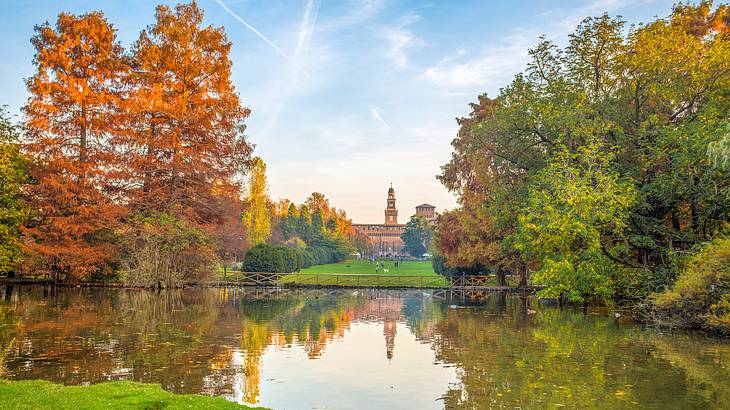
Sempione Park, Milan
Parco Sempione, or Sempione Park in English, is a large green space located near Castello Sforzesco in Milan. The park has an overall area of 47 hectares and was built between 1890 and 1893. There are several must-see attractions in the park.
You have the option of visiting Acquario Civico di Milano (The Civic Aquarium of Milan), Arco della Pace (the Triumphal Arch), Arena Civica (a multi-purpose arena), and La Triennale (a design and art museum). The Acquario Civico di Milano is an aquarium with 36 tanks housing about 100 animal species.
Sempione Park is one of the best places to be in Milan if you want to relax during your stay in Italy. There are also many activities for you to enjoy here, like taking a stroll, going for a bike ride, and simply taking your time to enjoy the amazing scenery.
☂️ Experience Parco Sempione with a tour

Sforzesco Castle, Milan
Sforzesco Castle was built by Francesco Sforza, the Duke of Milan, in the 15th century. The castle was later renovated and enlarged from the 16th to the 17th century, making it one of the largest castles in Europe.
The defence of the famous castle was designed by Leonardo da Vinci and is one of his masterpieces. Today, Sforzesco Castle is home to several specialised museums.
The Egyptian Museum is one of the popular museums in the castle and Florence. The Ancient Art Museum is another museum open to visitors with artworks from the medieval and renaissance times. You can also visit the Musical Instrument Museum, which exhibits musical instruments collected from the 15th to the 20th century BC.
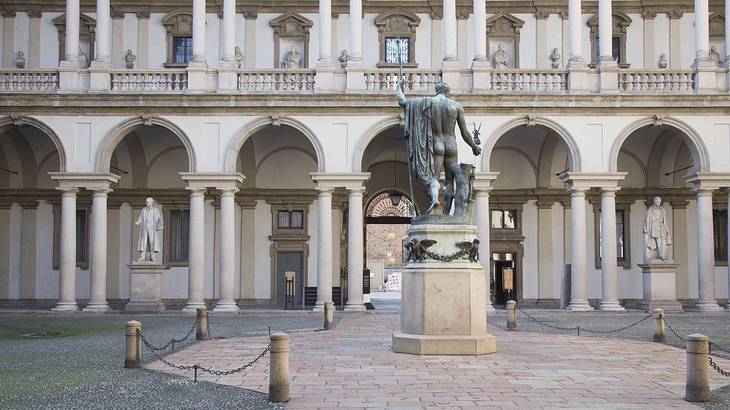
Pinacoteca di Brera, Milan
Milan, popularly known as the global capital of fashion and design, is the home of many famous monuments in Italy. Pinacoteca di Brera, a public art gallery, is one of the main attractions in the city.
The art gallery was founded by Napoleon I in 1809 and is one of the largest art galleries in Italy. The Pinacoteca di Brera was not established because of private collections belonging to noble families or important people, unlike other famous Italian museums.
The paintings and art collections found in the gallery have all been gathered through acquisitions, donations and exchanges, with more collections being added as time goes on. Pinacoteca di Brera has 38 halls with every painting arranged in chronological order.
☂️ Visit the Pinacoteca di Brera with an experience

Teatro Antico di Taormina, Sicily
The historic Teatro Antico di Taormina, a Greek-Roman theatre, is one of the most important and fascinating monuments in Taormina. Its location over the Ionian coast gives you a fantastic view of the sea.
The ancient amphitheatre may have been built in 265 B.C., but it is still well preserved to this day. It was first built as a Greek theatre to accommodate about 5,000 spectators for dramatic shows.
The Romans later renovated it to make room for games and gladiator battles. The theatre still hosts large events today, like opera shows, classical plays, and rock concerts.
The amphitheatre is the second-largest theatre in Sicily, after the Greek Theatre of Syracuse. It is divided into many areas; The Orchestra, The Cavea, The Portici, The Access Stairs, and the most important part, The Scene.
Sicily is excellent for a road trip in Italy. Consider spending at least 5 days in Sicily to make the most of your time on the island.
Mount Etna, Sicily
Mount Etna is one of the most active volcanoes in the world. It is located on the Italian island of Sicily, in the east of the island near Catania. The volcano frequently erupts, and plumes of smoke can usually be seen emanating from its summit.
Its colossal size, over 3,000 metres high, means that Mount Etna is visible from many places across the island. The volcano is listed as a UNESCO World Heritage Site due to its significant geological features.
The volcano can be visited independently, and there is a cable car to the summit. However, it is far more beneficial to take a guided tour of Mount Etna to get to grips with its history and geography fully. Off the beaten track, visitors can see lava bombs and ice caves hidden amid the lava fields and woodlands.
Although Mount Etna is responsible for much destruction over the centuries, it does provide incredibly fertile soil which helps to produce excellent wines on the slopes of the volcano.
In winter, there is skiing, and in summer, visitors flock to the Alcantara Gorge near the mountain. Mount Etna can be visited as a day trip from the nearby city of Catania or the pretty seaside town of Taormina.
Stromboli, Aeolian Islands
Stromboli is the most magical island off the coast of Sicily. It's one of Italy's three active volcanoes and one of the most active volcanoes on Earth. It has been active for the last 2,000 years.
Just sleeping on an active volcano is an exciting thing to do. But, of course, there are a lot of other awesome things to do here than just sleeping. You can walk along the island on its black sandy beaches or climb over huge colourful volcanic rocks.
While walking on the island and swimming in the sea, you can also admire the spectacular explosive eruptions of the Stromboli Volcano. Swimming in the Tyrrhenian sea around the volcano is unique because its water is so warm and balmy. It feels like an out of this world experience.
You can rent a kayak or boat and watch the fiery eruptions from there too. It might feel scary to be in the middle of the water, in a kayak, in front of a volcano continuously smoking and making noises like rumbling thunder, but it is an unforgettable moment.
The most popular thing to do here is to hike as close as possible to the craters of Stromboli at night. The highest summit crater is 926 meters above sea level.
However, as of today, due to the powerful volcanic activities, it's only possible to hike until 400 meters with a guide and only 300 meters above sea level without one. The experience can be very intense to the extent that you might feel like you're on fire (not literally).
Basilica of St. Francis of Assisi, Assisi
The Basilica of San Francesco d'Assisi surely has to be one of the most prominent and imposing Italian landmarks of all. Set on a ridge, the town of Assisi is home to this behemoth of a building, which can be seen dominating the skyline for miles by Italian road trippers as they approach across the golden Umbrian plains.
Assisi is the town in which St. Francis was born in 1181 and died in 1226. His remains are interred in the Basilica, a UNESCO World Heritage Site and one of the most important Christian pilgrimages in Italy, if not the world.
Begun in 1228 and consisting of two churches and a crypt, the Gothic and Romanesque Basilica showcases incredible frescoes by late medieval painters such as Cimabue and Giotto.
Some of these precious works were damaged by the earthquake of 1997, but have since been restored. Large sections of the vault have also been fixed up, which too almost entirely collapsed.
The town of Assisi is anchored by two medieval castles and between them are charming squares and pretty flower-filled streets lined with medieval buildings. There are many other religious buildings of importance in Assisi, like a Roman amphitheatre and a temple.
As you wander the cobbled alleys, the historic ambience is so thick it fills the air. Thronged with monks, nuns and pilgrims (as well as tourists), Assisi is on the Cammino di Francesco, which follows the footsteps of St. Francis.
But many come just to Assisi, which draws people from all corners of the globe to celebrate the remarkable life of St. Francis -- a boy born into privilege but who chose a life of simplicity and poverty in devotion to God.
☂️ Visit the Basilica of Saint Francis of Assisi with an excursion
- Heart of Umbria - Explore the Mystic Towns of Orvieto & Assisi (highly sought-after)
- Assisi & Orvieto - Full Day Tour From Rome in a Small Group (frequently earns a five-star rating)
Piazza del Campo, Siena
Piazza del Campo is not only a fantastic attraction in Siena, it is also probably one of the most well-known city squares in Italy, and therefore a famous Italian landmark. This former market square has always been the centre of the old town, and it is still the most popular meeting place for both tourists and locals.
Around the square are some of the most beautiful sights in the city. First and foremost is the Palazzo Pubblico, the town hall, and the imposing Torre del Mangia, a 102-meter-high tower that rises high above the roofs of the old town. The stunning Fonte Gaia fountain is also located directly in Piazza del Campo.
Around the Piazza del Campo are rows of old red and brown townhouses where numerous cosy restaurants and fabulous cafes invite you to take a sightseeing break.
With an Aperol or a coffee in hand, you can enjoy the Italian flair and soak up the unique atmosphere. Especially in the warm season, countless visitors sit here and marvel at the magic that surrounds this square.
This square in Siena is also world-famous for the Palio di Siena horse race, which has been held at the main square since the Middle Ages. This unique event takes place two times a year, on July 2 and August 16.
☂️ Join a tour to see Piazza del Campo
Alberobello, Puglia
Located in Southern Italy's Puglia region, the charming town of Alberobello and its many Trulli were designated a UNESCO World Heritage Site back in 1996. They are still, to this day, one of the country's most important Italian landmarks.
Trulli are mortarless houses made using limestone boulders with a pyramidal, domed or conical roof. They are symbolic of Puglia's Valle d'Itria.The unusual construction style of the Trulli dates back to the 16th century when local rulers wanted to avoid paying property taxes to the King, which were calculated based on the number of rooftops there were.
Hence, they ordered the local peasants to build their houses without mortar. This meant that in the event of a royal inspection, they could quickly dismantle them. Using local materials and innovative building techniques, the residents created the Trulli.
Although you can still find Trulli scattered across the Valle d'Itria, Alberobello has the highest concentration of them anywhere in the region. It is the only town still made up entirely of them, with around 2,000 Trulli across the town's three main zones.
While some of the Trulli remain family homes, many have been renovated. They are now holiday rentals, shops and restaurants that cater to the many tourists visiting the town to admire the unusual historic buildings.
Many people opt for a day trip to Alberobello to see the Trulli; however, one of the best times to explore the town is actually at night when most of the crowds are gone, and the narrow streets are lit up with rows of fairy lights. Plus, what a better way to see a Trulli than by staying in one overnight!
☂️ Visit Alberobello with a tour
Pompeii, Pompei
Pompeii is a 2000-year-old archaeological site located between the Amalfi Coast and Naples. The town is so well preserved that original paintings and artefacts are still in mint condition today.
If you are staying in this region, I recommend taking the train as there is a stop found right in front of the site. Some people travel from Rome to Pompeii, about 150 miles, but this trip is significantly longer.
Pompeii is an actual archaeological site that has been excavated and is still being dug up to this day. I highly recommend buying your tickets ahead of time or signing up for an official tour from a reputable company. There is so much history and fascinating facts you can learn as you explore the site.
Some of the sites worth visiting here are the ancient Roman baths, the Temple of the Isis (a popular cult during the Roman Empire), preserved homes from the middle and upper-class citizens, and many other ancient ruins.
As Pompeii is situated in a sweltering region of Italy during the summer, make sure to bring sunscreen, a hat, and water with you. There is absolutely no shade within the archaeological site. Also, do not buy tours from anyone standing outside the site. Make sure to plan ahead. Visiting Pompeii is like going back in time. It is a remarkable experience everyone should have!
☂️ Join a tour to see the Pompeii Archaeological Park
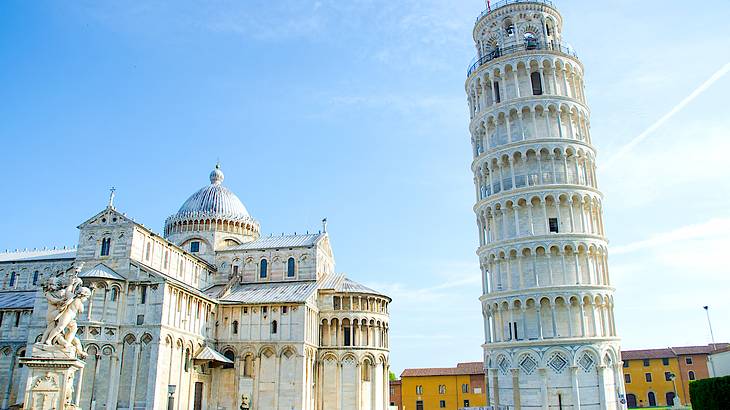
Leaning Tower of Pisa, Pisa
Pisa is a small city in Italy located west of Florence. In the city, there is a public square named Piazza dei Miracoli, which, when translated into English, means the Square of Miracles.
Piazza dei Miracoli is the home of a few famous monuments in Italy, like the Cathedral and the Baptistery. However, the Leaning Tower of Pisa, the third-oldest monument in Pisa, is the most famous monument in the city.
The tower stands at over 50 metres tall and attracts many visitors because of its leaning nature. The Leaning Tower of Pisa, with construction occurring between the 12th and 13th century, was not built with the intent of making it tilt.
The tilting started when construction began because the ground it was being built on was not strong enough to support the weight of the tower. The tower continued to lean towards the ground until it was eventually closed down in 1990 when it was tilting 5.5 degrees.
In 2001, the tower, after undergoing more than a decade of intense reconstruction, opened again to the public. Climbing to the top of the building gives you a fantastic view of the city.
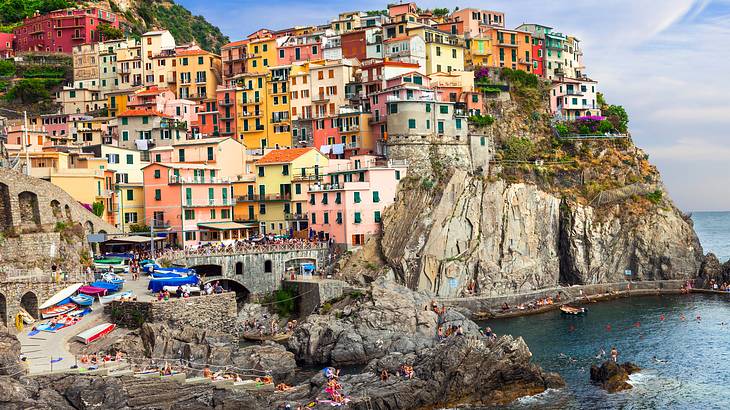
Cinque Terre, Liguria
Cinque Terre is a collection of five different towns along the Italian Riviera dating back to the 1200s. The towns that make up Cinque Terre are Manarola, Vernazza, Corniglia, Riomaggiore, and Monterosso al Mare, with each city being more beautiful and charming than the next.
Each town has its own character to show you, so taking the time to visit each one is worth it. Reaching Cinque Terre from Florence, Pisa, Rome, or Genoa is easy.
There are several activities for you to try once you get to Cinque Terre. One popular activity is hiking. There are many trails for you to walk on, with some linking all five towns together, making for an adventurous journey.
Cinque Terre has rocky coves suitable for swimming as well. You can also rent a small boat if you know how to drive one, or sign up with a boat tour company to explore each town's coast.
☂️ Visit Cinque Terre with a tour
- Cinque Terre Sunset Tour (frequently earns a five-star rating)
- Cinque Terre Private Tour by Minivan & Ferry-Boat Shore Excursion From Livorno
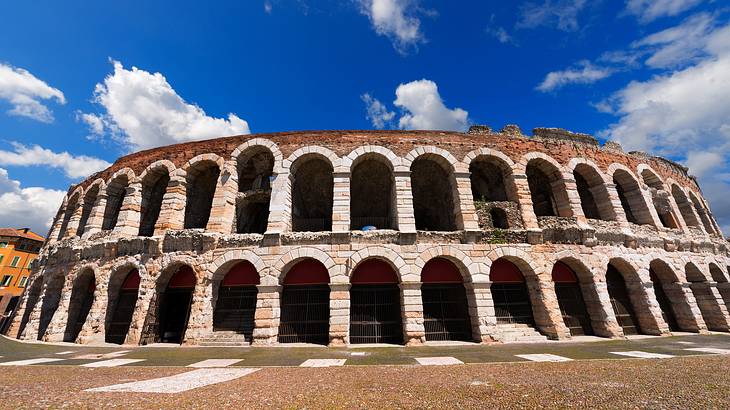
Verona Arena, Verona
Verona Arena, built in the first half of the 1st century A.D., is a Roman Amphitheatre located in Piazza Bra. The amphitheatre is one of the largest in Italy and a famous monument in Verona.
The Verona Arena once hosted historical events, such as gladiator shows and beast fights. Today, the arena is used to host large-scale opera festivals every year.
You can visit this historic monument year-round. You should visit during the summer when the amphitheatre is most lively due to the annual Opera Festival.
☂️ Discover the Verona Arena on a tour
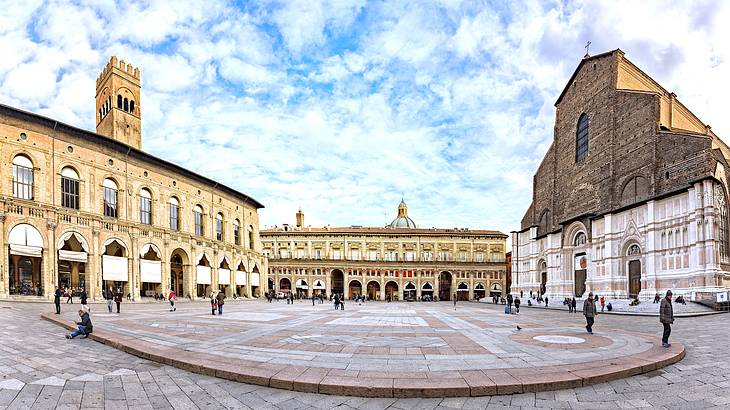
Piazza Maggiore, Bologna
Bologna is a beautiful must-see city in Italy with several places for you to visit. If you're wondering where to stay in Bologna, Centro Storico is an excellent choice and puts you near many landmarks, like Piazza Maggiore.
Piazza Maggiore is the main square of Bologna, surrounded by many important monuments in the city. The idea of the square began in 1200 when city hall decided that it was time for the town to build a meeting place for the Bolognese people. The square still maintains its medieval charm, attracting millions of visitors to Bologna every year.
Almost every major tourist attraction in Bologna can be reached on foot from Piazza Maggiore. Some of the attractions include Palazzo della Podestà, the Basilica of San Petronius, and the main street in the city, Via dell'Indipendenza.
☂️ Visit Piazza Maggiore with an experience
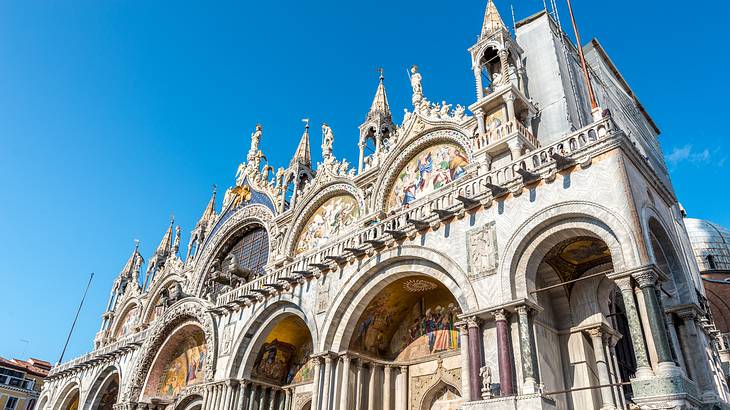
Saint Mark's Basilica, Venice
The construction of Saint Mark's Basilica, one of the must-see monuments in Venice, began in 828 and ended in 832. One interesting fact about the Church is that the one you see today is not the same one that was built in the 9th century.
The structure built in 832 was destroyed by a fire, meaning it needed to be rebuilt. The church you see today was built in 1063, and it symbolises the wealth and power of the people of Venice. It became the city's official cathedral in 1807.
The Basilica is one of the most beautiful churches in Europe and the world. In recent years, it has undergone many restructurings, but it still maintains its beauty that mesmerises visitors every time.
You can also take a detour after visiting the Basilica towards Doge's Palace located next to it. Make sure to buy tickets in advance if you choose to visit the Palace, even if you're in Venice for a few days.
☂️ Visit Saint Marks Basilica with an experience
Conclusion
Italy is a country filled with ancient history, unique culture and beautiful landmarks. You will not be short of options to explore when you visit here.
The capital of Italy, Rome, has many famous Italian buildings for you to see in particular, but some times having too much choice can make it hard to plan. I hope this Italy travel guide has helped you plan your trip to Italy, even in the slightest way!
Want to keep exploring?
Subscribe for discounts on tickets and hotels and our latest guides.
Thank you for subscribing
We will be in touch soon with discounts on tickets and hotels and our latest guides.
Want to keep exploring?
Subscribe for discounts on tickets and hotels and our latest guides.
Thank you for subscribing
We will be in touch soon with discounts on tickets and hotels and our latest guides.



